Lona Manning's Blog, page 8
January 10, 2024
CMP#168 "Clouds of Mystery"
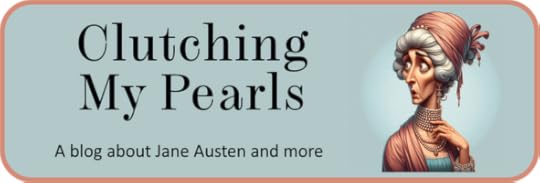 This blog explores social attitudes in Jane Austen's time, discusses her novels, reviews forgotten 18th century novels, and throws
some occasional shade
at the modern academy. The introductory post is here. My "six simple questions for academics" post is here. CMP#168 A Modern Incident in Domestic Life (1803) by Isabella Kelly
This blog explores social attitudes in Jane Austen's time, discusses her novels, reviews forgotten 18th century novels, and throws
some occasional shade
at the modern academy. The introductory post is here. My "six simple questions for academics" post is here. CMP#168 A Modern Incident in Domestic Life (1803) by Isabella Kelly
 Felicity Jones as Catherine Morland, engrossed in a mysterious gothic When I finished Volume One of A Modern Incident, I was half-way through the novel and I still had absolutely no idea what was going on. No idea. So far we just had:
Felicity Jones as Catherine Morland, engrossed in a mysterious gothic When I finished Volume One of A Modern Incident, I was half-way through the novel and I still had absolutely no idea what was going on. No idea. So far we just had:Page after page of characters stammering out incoherent remarks (dashes and dots in the original):“Thy looks! –I feel them, --they will d---n me yet!”)“I cannot pray! –I will not—no—Hell is but reprobation—that is mine already—or will be soon --- ---- ---- --- --- Yet, --but him [Mr. Winstanley, that is] I now hate—I know him,--he knows not me,---no, nor my deeds.—One effort yet, to cool this burning fever, to ease this secret torture, --this---this—Oh, Mortimore! –Mortimore!—Thee!—this—and if I fail! –be they blasted in all hope, --and I!—dark perdition cover me for ever—ever--!”“Why Mrs. Courtney uttered such a frantic shriek, or what caused such violent emotion, the reader is left to imagine…” Page after page of characters harboring a secret:“the secrets of another are not my own.”"I have already told you... that I never mean to marry." And characters turning pale and rushing from the room: "With these incoherent and inexplicable words, he rushed with frantic impetuousity from their presence.” Perhaps a gothic novel aficionado would be familiar with the tropes and plot devices that baffled me and would figure out the Big Secret before it was revealed in the penultimate chapter, but I only persisted with the book because it was a quick read; a two-volume novel which had not been reviewed when it came out.
And holy snapping turtles, this had some lurid stuff; at least, lurid compared to the decorous voice of Jane Austen. This has several same-sex teases, and an incest tease, and a ghost-who-turns-out-to-be not a ghost, adultery and seduction, along with forged letters and other skullduggery. Get your smelling salts out for this one. The book got me thinking about Emma, in which the reader is kept in the dark about the Frank Churchill/Jane Fairfax romance until the end. When you get to the revelation in Emma, you realize that there were a lot of clues that you missed: Frank’s abrupt decision to go to London, supposedly to get his hair cut, Jane’s insistence on picking up her own letters at the post office, the way Frank encouraged Emma to think that Jane and Mr. Dixon were attracted to each other… Can this be said of A Modern Incident as well--can the reader keep track of the hints that are dropped?
Let's meet our main characters: a brother and sister team, Frederick and Ellen Mortimore. Frederick is empathetic, gentle, rational, and introverted and Ellen is ardent, impulsive, intelligent, and accomplished. They should arouse our sympathies because they have fallen on hard times, but it was challenging for me to stay engaged when their motivations were withheld by the author, and through various hints we learn that they are not who they claim to be. “I have no patience,--I cannot bear it!” repeated Mortimore, with an energy of voice and manner which made even Ellen’s spirit shrink, “do you forgot who and what you are?”
“No!” cried Ellen, and her colour deepened to crimson, “nor do, nor can I forget who and what you are either!” “She is not my sister.” [Frederick tells Mrs. Winstanley.}
“And you love her?”
“Dearly love her.”
“You prefer her to all her sex?”
“Not entirely.”
“NO! –well, one bed, I suspect has served you both before now?”
“To be candid, one bed served us long.”
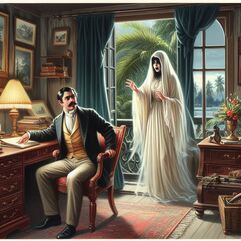 "Farewell! Wed not! Remember Ceceline!" “Try to love you!” repeated Mortimore, with irrepressible emotion….“Still!” he repeated, his eyes wild, yet fixed with strange and piercing meaning on [Mrs. Winstanley]. She was dull,--she understood not the silent intellligence.” (Join the club, sister).
"Farewell! Wed not! Remember Ceceline!" “Try to love you!” repeated Mortimore, with irrepressible emotion….“Still!” he repeated, his eyes wild, yet fixed with strange and piercing meaning on [Mrs. Winstanley]. She was dull,--she understood not the silent intellligence.” (Join the club, sister).
 Balm? Sorry, you're on your own The other main character, Mr. Winstanley, “an Englishman of family and high connexions.. [who is] allowed to be the most handsome, sensible, and accomplished man in the Island” also didn’t arouse my sympathy because he was a selfish philanderer. He asks Frederick to tell his pregnant and discarded mistress Annette, that he (Mr. Winstanley) is going to marry a rich widow. Frederick “poured the balm of consolation on [Annette’s] wounded heart” and inspired her to renounce her life of sin. Her baby is born dead, and she disappears from the narrative. If all that's not enough, Mr. Winstanley is a plantation-owner (the story is set in Barbados) as is the kindly older mentor female figure, Mrs. Courtney. More on that later.
Balm? Sorry, you're on your own The other main character, Mr. Winstanley, “an Englishman of family and high connexions.. [who is] allowed to be the most handsome, sensible, and accomplished man in the Island” also didn’t arouse my sympathy because he was a selfish philanderer. He asks Frederick to tell his pregnant and discarded mistress Annette, that he (Mr. Winstanley) is going to marry a rich widow. Frederick “poured the balm of consolation on [Annette’s] wounded heart” and inspired her to renounce her life of sin. Her baby is born dead, and she disappears from the narrative. If all that's not enough, Mr. Winstanley is a plantation-owner (the story is set in Barbados) as is the kindly older mentor female figure, Mrs. Courtney. More on that later.Do I care that Winstanley is harboring a guilty secret? “Distraction!” he shrieked. “I am –I am undone! “…………….bear thy beloved image where passion can no more………. The virtues lingering in thy bosom…..” and “They are dead! –perished” cried he, starting, “I am not human! –What can I do? –Retreat! –Perdition! –What then? –Oh, thought! thought! thought! split not my burning brain!”
How could this book get worse? That’s right, poetry. There’s some poetry. And a ghost. Spoilers from here on:
I’m introducing the spoilers early, to avoid going through the plot of the book twice: Mr. Winstanley changed his name from Fitzalvan when he left England with his mistress, erroneously thinking that his wife was in love with another. He abandoned Ceceline and his children without a word and he changed his name. The young man Frederick Mortimore turns out to be Ceceline in disguise, and Ellen Mortimore is really his son Arthur. They cross-dress throughout the story, so the author can give us scenes like the lovely young Antonia Courtney declaring her love for Ellen:
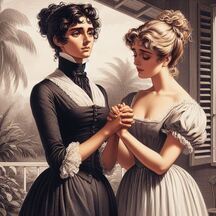 Image generated by Bing AI “I cannot leave you!” cried Antonia. “Dear, dear Ellen can you leave me! –what will you do?”
Image generated by Bing AI “I cannot leave you!” cried Antonia. “Dear, dear Ellen can you leave me! –what will you do?”“I shall run wild—distracted!”
“Run wild!” repeated she, “let us run any where, so as it is together.—to leave me now, now when I have learned to love you, learned to be almost like you—”
“In pity say no more, Antonia,” interrupted Ellen, her cheeks in a conscious glow, “I cannot bear it.”
“Promise me then to stay with me,” [Antonia pleads, asking Ellen not to take a governess job she’s been offered, fearing that her employer will fall in love with her], you will marry him, and then—”
“Marry him!” cried Ellen, interrupting her, “no, Antonia, I will never marry anyone that would divide me from you,--do not fear,--do not think it.” The revelation that Frederick Mortimore is Winstanley's wronged wife explains this once-incomprehensible speech: “Oh, this, indeed, is insupportable,” cried [Mortimore], staggering against the wall, as he entered the house, “to see it! –hear it! –what, in my very sight! – Oh, Annette, Annette, little do you know –who—Distraction!—What is this?—I cannot bear it!”
Later, Mr. Winstanley is deathly ill and the doctor declares the only possible cure is for somebody to use their human body heat to snuggle in bed with him all night and break his fever. Winstanley’s new wife refuses to do it, his mistress Harriet refuses to do it, so Frederick volunteers to do it. He sends everyone out of the room, then: “He hastily undressed and stepped into the bed, raising his eyes to Heaven… He clasped Winstanley in his arms, and folded him to his throbbing breast….”
We have Mr. Winstanley trying to proposition Ellen, unaware that he’s hitting on his own son. We have his mistress Harriet making a play for Frederick, unaware that it’s her old best friend Ceceline who she betrayed.
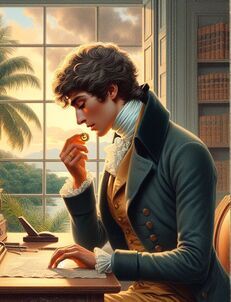 "Frederick" finds "Ceceline's" wedding ring. Bing AI generated image. What makes all these teasers acceptable is that it’s all a morality play, it’s all a don’t try this at home, kids. Or this, either. Or things like this. Don't worry, Antonia has really fallen in love with a man and Frederick is the long-lost,
heroically forbearing,
loyal wife of Winstanley. The author injects a sermonette: “Turn, youth!—turn, innocence, and view the picture!—and should your unwary feet, unguided by prudence, unsupported by rectitude, have taken one little step towards error, look back, and, oh. Retreat! –Consider, dishonour is the wreck of peace,--the blight of every hope,--the canker of every joy;--like a malign fiend it pursues through every path in lie,--it goads on to the very bed of death itself—and even there forsakes not, for it survives the grave.”
"Frederick" finds "Ceceline's" wedding ring. Bing AI generated image. What makes all these teasers acceptable is that it’s all a morality play, it’s all a don’t try this at home, kids. Or this, either. Or things like this. Don't worry, Antonia has really fallen in love with a man and Frederick is the long-lost,
heroically forbearing,
loyal wife of Winstanley. The author injects a sermonette: “Turn, youth!—turn, innocence, and view the picture!—and should your unwary feet, unguided by prudence, unsupported by rectitude, have taken one little step towards error, look back, and, oh. Retreat! –Consider, dishonour is the wreck of peace,--the blight of every hope,--the canker of every joy;--like a malign fiend it pursues through every path in lie,--it goads on to the very bed of death itself—and even there forsakes not, for it survives the grave.”Mr. Winstanley survives the fever, thanks to Ceceline, but she catches it and her true identity is unmasked on her death bed with more incoherent stammering; “Oh, mourn not me! –look—your son, as Ellen, he sustained—watched his mother! –Now—now—my latest—only love, I die—dying for you! –Oh, happy—happy!—Your children--- --- my --- --- --- --- --- my god! –my Fitzavern!”
Ceceline’s death is fatal for her husband: “He made one essay to speak, but this lips only moved, and the words choaked him! He raised Ceceline’s head to his bosom—folded the cold corse within his arms—and with one—only one groan—it was his last—he sunk—he was gone—he never breathed again—and Fitzavern was with Ceceline!!! ___ ___ ___ ___ ___ ___ ___ ___ ___ ___ ___ ___ ___ ___ ___ ___ I might have missed it, but I saw no reason why Ceceline and her son had to conceal themselves under clouds of mystery, or why doing so did anything to resolve their problems rather than complicate them. Once Ceceline received a convenient inheritance of fifty thousand pounds from the convenient death of her uncle, she could have shipped herself off to Barbardos and accused her husband of bigamy. Then it would have come out that Harriet, who called herself Mrs. Winstanley, was not legally married to him.
Mr. Winstanley did become a bigamist when he married the rich widow. But instead of going to the minister and preventing this crime from occurring, Ceceline dressed herself up as a ghost (as one does) and appeared before him, futilely warning him not to marry.
The marriage didn’t prosper anyway, because the rich widow’s: “long unrestrained passions, voluptuous living, and high pampered appetites, had left her vitiated mind only fit for the vilest gratifications; and as they ill suited the natural delicacy of Winstanley’s taste,” she paid for a gigolo.
So really, in this novel, people do senseless things and it turns out they accomplish nothing. Except for the deceitful mistress Harriet, I suppose. She succeeded in luring Winstanley/Fitzavern away from Ceceline by forging a letter. She comes to a miserable end, though, we are told.
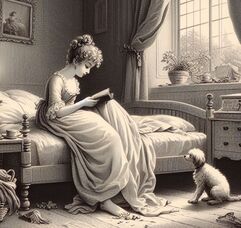 Gothic titillation and confusing clues. Imagine generated by Bing AI. Catching all the clues
Gothic titillation and confusing clues. Imagine generated by Bing AI. Catching all the cluesI wonder if the young ladies poring over this tale had any notion what “the vilest gratifications” and the "degrading passions" of the rich widow might be. Or how did they interpret "irresistible nature" and "broke forth" in this passage: "The young and interesting Antonia hanging with easy, innocent fondness on his bosom… proved too much for the high and ardent spirits of…. Arthur Fitzavern; --nature, irresistible nature broke forth, and without either motion or speech betraying, Mrs. Courtney penetrated the secret.”
Hopefully the female readers spent more time pondering the double standard the author upholds between male and female conduct. But more than that, I wonder: did the early readers of this book recollect every previously-inexplicable detail that had gone before the Big Reveal, and did they say to themselves, aha, so when Frederick/Ceceline turned pale and rushed away when Harriet Winstanley arrived at Mrs. Courtney’s, it’s because she recognized her old-backstabbing friend. Or, did they turn back to volume one to re-skim all those passages which made no sense before?
Jane Austen is not the first to string clues and hints throughout her tale, but we can read and re-read Emma with pleasure, finding some new nuance to savor every time. Austen can withhold information from us and still create a coherent and interesting story that doesn't rely on salacious details to keep us turning the pages. Content warning: this section reproduces callous references to enslaved people
The other aspect of this book which might be of interest is the matter-of-fact portrayal of enslavement in Barbados. No amount of academic detachment is going to prepare you for certain words strung together in a certain way, such as: Mrs. Courtney’s “slaves were numerous, and it was her pleasure to let them live happily. Her plantations were extensive, and they not only sheltered and supplied the sable inhabitants in her service, but also gave employment and independence to many Europeans and their families.”
As well it's jarring, to say the least, to see Winstanley, a plantation-owner, speak blithely to the rich widow about love, slaves and chains:
“Thou art a dear provoking wretch, Winstanley,” [says the widow flirtatiously]
“I would provoke you,” kissing her hand, “to make me a willing slave for life. –How I should glory in my chains!”
“They shall hang easy on you,” cried the lady, “do not fear them—”
“Fear them!” interrupted he, “I die,--I languish for them!”
These passages, and others, tell us that although abolition had been hotly debated, you could still encounter a variety of opinions in the novels of the day, from vehement abolitionism to casual acceptance of enslavement. Whichever side you were on, there was no need to use veiled allusions.
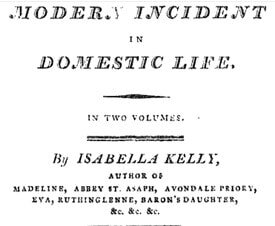 About the author:
About the author:Isabella Kelly (1759–1857) was a prolific authoress, chiefly of Gothic novels, who supported her children after her two marriages did not prosper. She lived in poverty most of her life. She lived to the age of 98, calling herself the last surviving novelist of her era. In A Modern Incident, she worked in some lavish praise of the successful author Matthew “Monk” Lewis, “one whose nature reflects honour on the human kind,” because he had been helping one of her sons find work. James Fordyce, of Fordyce’s Sermons, was her uncle.
Scholar Yael Shapiro points out that Kelly focused on marital troubles in her novels, as opposed to ending her books with weddings: “Where [Gothic best-seller Ann] Radcliffe sets up a sharp dichotomy between good and bad marriages, Kelly’s novels seem to accept men’s controlling behavior as a possible part of any marriage.”
Rachel Feder, in a new book about Jane Austen and cultural tropes (of which much more in future) points out “Gothic novels… simultaneously offered an escape from and a commentary on the real world, which has always been dangerous for women [the real world, that is]. [T]hese stories were often subversive but not particularly progressive.”
That's certainly my take on A Modern Incident." We have some subversive fun with some same-sex and incest teases, (if that's your idea of fun), then the author winds up her tale with more double-standard morality: “Let the sons of pleasure and indulgence, should any such ever turn this melancholy page, learn from the fate of Fitzavern, that if they do not restrain the irregularity of wild desires when they ought, they may not be able to do it when they would.--but that consequences come with ruin, and with despair.
“And let the daughters of pain and disappointment, when dropping a tear to the sorrows, and the memory of Ceceline, not suppose such sorrows were in vain;--they purified her for a society of angels, and purchased her an early immortality.” Shapira, Yael. “Beyond the Radcliffe Formula: Isabella Kelly and the Gothic Troubles of the Married Heroine.” Women's Writing: the Elizabethan to Victorian Period, vol. 26, no. 3, 2019, pp. 245–63.
Previous post: Innocent Ellen, a gothic heroine
Published on January 10, 2024 00:00
CMP# A Modern Incident in Domestic Life
 This blog explores social attitudes in Jane Austen's time, discusses her novels, reviews forgotten 18th century novels, and throws
some occasional shade
at the modern academy. The introductory post is here. My "six simple questions for academics" post is here. CMP#168 A Modern Incident in Domestic Life (1803) by Isabella Kelly
This blog explores social attitudes in Jane Austen's time, discusses her novels, reviews forgotten 18th century novels, and throws
some occasional shade
at the modern academy. The introductory post is here. My "six simple questions for academics" post is here. CMP#168 A Modern Incident in Domestic Life (1803) by Isabella Kelly
 Felicity Jones as Catherine Morland, engrossed in a mysterious gothic When I finished Volume One of A Modern Incident, I was half-way through the novel and I still had absolutely no idea what was going on. No idea. So far we just had:
Felicity Jones as Catherine Morland, engrossed in a mysterious gothic When I finished Volume One of A Modern Incident, I was half-way through the novel and I still had absolutely no idea what was going on. No idea. So far we just had:Page after page of characters stammering out incoherent remarks (dashes and dots in the original):“Thy looks! –I feel them, --they will d---n me yet!”)“I cannot pray! –I will not—no—Hell is but reprobation—that is mine already—or will be soon --- ---- ---- --- --- Yet, --but him [Mr. Winstanley, that is] I now hate—I know him,--he knows not me,---no, nor my deeds.—One effort yet, to cool this burning fever, to ease this secret torture, --this---this—Oh, Mortimore! –Mortimore!—Thee!—this—and if I fail! –be they blasted in all hope, --and I!—dark perdition cover me for ever—ever--!”“Why Mrs. Courtney uttered such a frantic shriek, or what caused such violent emotion, the reader is left to imagine…” Page after page of characters harboring a secret:“the secrets of another are not my own.”"I have already told you... that I never mean to marry." And characters turning pale and rushing from the room: "With these incoherent and inexplicable words, he rushed with frantic impetuousity from their presence.” Perhaps a gothic novel aficionado would be familiar with the tropes and plot devices that baffled me and would figure out the Big Secret before it was revealed in the penultimate chapter, but I only persisted with the book because it was a quick read; a two-volume novel which had not been reviewed when it came out.
And holy snapping turtles, this had some lurid stuff; at least, lurid compared to the decorous voice of Jane Austen. This has several same-sex teases, and an incest tease, and a ghost-who-turns-out-to-be not a ghost, adultery and seduction, along with forged letters and other skullduggery. Get your smelling salts out for this one. The book got me thinking about Emma, in which the reader is kept in the dark about the Frank Churchill/Jane Fairfax romance until the end. When you get to the revelation in Emma, you realize that there were a lot of clues that you missed: Frank’s abrupt decision to go to London, supposedly to get his hair cut, Jane’s insistence on picking up her own letters at the post office, the way Frank encouraged Emma to think that Jane and Mr. Dixon were attracted to each other… Can this be said of A Modern Incident as well--can the reader keep track of the hints that are dropped?
Let's meet our main characters: a brother and sister team, Frederick and Ellen Mortimore. Frederick is empathetic, gentle, rational, and introverted and Ellen is ardent, impulsive, intelligent, and accomplished. They should arouse our sympathies because they have fallen on hard times, but it was challenging for me to stay engaged when their motivations were withheld by the author, and through various hints we learn that they are not who they claim to be. “I have no patience,--I cannot bear it!” repeated Mortimore, with an energy of voice and manner which made even Ellen’s spirit shrink, “do you forgot who and what you are?”
“No!” cried Ellen, and her colour deepened to crimson, “nor do, nor can I forget who and what you are either!” “She is not my sister.” [Frederick tells Mrs. Winstanley.}
“And you love her?”
“Dearly love her.”
“You prefer her to all her sex?”
“Not entirely.”
“NO! –well, one bed, I suspect has served you both before now?”
“To be candid, one bed served us long.”
 "Farewell! Wed not! Remember Ceceline!" “Try to love you!” repeated Mortimore, with irrepressible emotion….“Still!” he repeated, his eyes wild, yet fixed with strange and piercing meaning on [Mrs. Winstanley]. She was dull,--she understood not the silent intellligence.” (Join the club, sister).
"Farewell! Wed not! Remember Ceceline!" “Try to love you!” repeated Mortimore, with irrepressible emotion….“Still!” he repeated, his eyes wild, yet fixed with strange and piercing meaning on [Mrs. Winstanley]. She was dull,--she understood not the silent intellligence.” (Join the club, sister).
 Balm? Sorry, you're on your own The other main character, Mr. Winstanley, “an Englishman of family and high connexions.. [who is] allowed to be the most handsome, sensible, and accomplished man in the Island” also didn’t arouse my sympathy because he was a selfish philanderer. He asks Frederick to tell his pregnant and discarded mistress Annette, that he (Mr. Winstanley) is going to marry a rich widow. Frederick “poured the balm of consolation on [Annette’s] wounded heart” and inspired her to renounce her life of sin. Her baby is born dead, and she disappears from the narrative. If all that's not enough, Mr. Winstanley is a plantation-owner (the story is set in Barbados) as is the kindly older mentor female figure, Mrs. Courtney. More on that later.
Balm? Sorry, you're on your own The other main character, Mr. Winstanley, “an Englishman of family and high connexions.. [who is] allowed to be the most handsome, sensible, and accomplished man in the Island” also didn’t arouse my sympathy because he was a selfish philanderer. He asks Frederick to tell his pregnant and discarded mistress Annette, that he (Mr. Winstanley) is going to marry a rich widow. Frederick “poured the balm of consolation on [Annette’s] wounded heart” and inspired her to renounce her life of sin. Her baby is born dead, and she disappears from the narrative. If all that's not enough, Mr. Winstanley is a plantation-owner (the story is set in Barbados) as is the kindly older mentor female figure, Mrs. Courtney. More on that later.Do I care that Winstanley is harboring a guilty secret? “Distraction!” he shrieked. “I am –I am undone! “…………….bear thy beloved image where passion can no more………. The virtues lingering in thy bosom…..” and “They are dead! –perished” cried he, starting, “I am not human! –What can I do? –Retreat! –Perdition! –What then? –Oh, thought! thought! thought! split not my burning brain!”
How could this book get worse? That’s right, poetry. There’s some poetry. And a ghost. Spoilers from here on:
I’m introducing the spoilers early, to avoid going through the plot of the book twice: Mr. Winstanley changed his name from Fitzalvan when he left England with his mistress, erroneously thinking that his wife was in love with another. He abandoned Ceceline and his children without a word and he changed his name. The young man Frederick Mortimore turns out to be Ceceline in disguise, and Ellen Mortimore is really his son Arthur. They cross-dress throughout the story, so the author can give us scenes like the lovely young Antonia Courtney declaring her love for Ellen:
 Image generated by Bing AI “I cannot leave you!” cried Antonia. “Dear, dear Ellen can you leave me! –what will you do?”
Image generated by Bing AI “I cannot leave you!” cried Antonia. “Dear, dear Ellen can you leave me! –what will you do?”“I shall run wild—distracted!”
“Run wild!” repeated she, “let us run any where, so as it is together.—to leave me now, now when I have learned to love you, learned to be almost like you—”
“In pity say no more, Antonia,” interrupted Ellen, her cheeks in a conscious glow, “I cannot bear it.”
“Promise me then to stay with me,” [Antonia pleads, asking Ellen not to take a governess job she’s been offered, fearing that her employer will fall in love with her], you will marry him, and then—”
“Marry him!” cried Ellen, interrupting her, “no, Antonia, I will never marry anyone that would divide me from you,--do not fear,--do not think it.” The revelation that Frederick Mortimore is Winstanley's wronged wife explains this once-incomprehensible speech: “Oh, this, indeed, is insupportable,” cried [Mortimore], staggering against the wall, as he entered the house, “to see it! –hear it! –what, in my very sight! – Oh, Annette, Annette, little do you know –who—Distraction!—What is this?—I cannot bear it!”
Later, Mr. Winstanley is deathly ill and the doctor declares the only possible cure is for somebody to use their human body heat to snuggle in bed with him all night and break his fever. Winstanley’s new wife refuses to do it, his mistress Harriet refuses to do it, so Frederick volunteers to do it. He sends everyone out of the room, then: “He hastily undressed and stepped into the bed, raising his eyes to Heaven… He clasped Winstanley in his arms, and folded him to his throbbing breast….”
We have Mr. Winstanley trying to proposition Ellen, unaware that he’s hitting on his own son. We have his mistress Harriet making a play for Frederick, unaware that it’s her old best friend Ceceline who she betrayed.
 "Frederick" finds "Ceceline's" wedding ring. Bing AI generated image. What makes all these teasers acceptable is that it’s all a morality play, it’s all a don’t try this at home, kids. Or this, either. Or things like this. Don't worry, Antonia has really fallen in love with a man and Frederick is the long-lost,
heroically forbearing,
loyal wife of Winstanley. The author injects a sermonette: “Turn, youth!—turn, innocence, and view the picture!—and should your unwary feet, unguided by prudence, unsupported by rectitude, have taken one little step towards error, look back, and, oh. Retreat! –Consider, dishonour is the wreck of peace,--the blight of every hope,--the canker of every joy;--like a malign fiend it pursues through every path in lie,--it goads on to the very bed of death itself—and even there forsakes not, for it survives the grave.”
"Frederick" finds "Ceceline's" wedding ring. Bing AI generated image. What makes all these teasers acceptable is that it’s all a morality play, it’s all a don’t try this at home, kids. Or this, either. Or things like this. Don't worry, Antonia has really fallen in love with a man and Frederick is the long-lost,
heroically forbearing,
loyal wife of Winstanley. The author injects a sermonette: “Turn, youth!—turn, innocence, and view the picture!—and should your unwary feet, unguided by prudence, unsupported by rectitude, have taken one little step towards error, look back, and, oh. Retreat! –Consider, dishonour is the wreck of peace,--the blight of every hope,--the canker of every joy;--like a malign fiend it pursues through every path in lie,--it goads on to the very bed of death itself—and even there forsakes not, for it survives the grave.”Mr. Winstanley survives the fever, thanks to Ceceline, but she catches it and her true identity is unmasked on her death bed with more incoherent stammering; “Oh, mourn not me! –look—your son, as Ellen, he sustained—watched his mother! –Now—now—my latest—only love, I die—dying for you! –Oh, happy—happy!—Your children--- --- my --- --- --- --- --- my god! –my Fitzavern!”
Ceceline’s death is fatal for her husband: “He made one essay to speak, but this lips only moved, and the words choaked him! He raised Ceceline’s head to his bosom—folded the cold corse within his arms—and with one—only one groan—it was his last—he sunk—he was gone—he never breathed again—and Fitzavern was with Ceceline!!! ___ ___ ___ ___ ___ ___ ___ ___ ___ ___ ___ ___ ___ ___ ___ ___ I might have missed it, but I saw no reason why Ceceline and her son had to conceal themselves under clouds of mystery, or why doing so did anything to resolve their problems rather than complicate them. Once Ceceline received a convenient inheritance of fifty thousand pounds from the convenient death of her uncle, she could have shipped herself off to Barbardos and accused her husband of bigamy. Then it would have come out that Harriet, who called herself Mrs. Winstanley, was not legally married to him.
Mr. Winstanley did become a bigamist when he married the rich widow. But instead of going to the minister and preventing this crime from occurring, Ceceline dressed herself up as a ghost (as one does) and appeared before him, futilely warning him not to marry.
The marriage didn’t prosper anyway, because the rich widow’s: “long unrestrained passions, voluptuous living, and high pampered appetites, had left her vitiated mind only fit for the vilest gratifications; and as they ill suited the natural delicacy of Winstanley’s taste,” she paid for a gigolo.
So really, in this novel, people do senseless things and it turns out they accomplish nothing. Except for the deceitful mistress Harriet, I suppose. She succeeded in luring Winstanley/Fitzavern away from Ceceline by forging a letter. She comes to a miserable end, though, we are told.
 Gothic titillation and confusing clues. Imagine generated by Bing AI. Catching all the clues
Gothic titillation and confusing clues. Imagine generated by Bing AI. Catching all the cluesI wonder if the young ladies poring over this tale had any notion what “the vilest gratifications” and the "degrading passions" of the rich widow might be. Or how did they interpret "irresistible nature" and "broke forth" in this passage: "The young and interesting Antonia hanging with easy, innocent fondness on his bosom… proved too much for the high and ardent spirits of…. Arthur Fitzavern; --nature, irresistible nature broke forth, and without either motion or speech betraying, Mrs. Courtney penetrated the secret.”
Hopefully the female readers spent more time pondering the double standard the author upholds between male and female conduct. But more than that, I wonder: did the early readers of this book recollect every previously-inexplicable detail that had gone before the Big Reveal, and did they say to themselves, aha, so when Frederick/Ceceline turned pale and rushed away when Harriet Winstanley arrived at Mrs. Courtney’s, it’s because she recognized her old-backstabbing friend. Or, did they turn back to volume one to re-skim all those passages which made no sense before?
Jane Austen is not the first to string clues and hints throughout her tale, but we can read and re-read Emma with pleasure, finding some new nuance to savor every time. Austen can withhold information from us and still create a coherent and interesting story that doesn't rely on salacious details to keep us turning the pages. Content warning: this section reproduces callous references to enslaved people
The other aspect of this book which might be of interest is the matter-of-fact portrayal of enslavement in Barbados. No amount of academic detachment is going to prepare you for certain words strung together in a certain way, such as: Mrs. Courtney’s “slaves were numerous, and it was her pleasure to let them live happily. Her plantations were extensive, and they not only sheltered and supplied the sable inhabitants in her service, but also gave employment and independence to many Europeans and their families.”
As well it's jarring, to say the least, to see Winstanley, a plantation-owner, speak blithely to the rich widow about love, slaves and chains:
“Thou art a dear provoking wretch, Winstanley,” [says the widow flirtatiously]
“I would provoke you,” kissing her hand, “to make me a willing slave for life. –How I should glory in my chains!”
“They shall hang easy on you,” cried the lady, “do not fear them—”
“Fear them!” interrupted he, “I die,--I languish for them!”
These passages, and others, tell us that although abolition had been hotly debated, you could still encounter a variety of opinions in the novels of the day, from vehement abolitionism to casual acceptance of enslavement. Whichever side you were on, there was no need to use veiled allusions.
 About the author:
About the author:Isabella Kelly (1759–1857) was a prolific authoress, chiefly of Gothic novels, who supported her children after her two marriages did not prosper. She lived in poverty most of her life. She lived to the age of 98, calling herself the last surviving novelist of her era. In A Modern Incident, she worked in some lavish praise of the successful author Matthew “Monk” Lewis, “one whose nature reflects honour on the human kind,” because he had been helping one of her sons find work. James Fordyce, of Fordyce’s Sermons, was her uncle.
Scholar Yael Shapiro points out that Kelly focused on marital troubles in her novels, as opposed to ending her books with weddings: “Where [Gothic best-seller Ann] Radcliffe sets up a sharp dichotomy between good and bad marriages, Kelly’s novels seem to accept men’s controlling behavior as a possible part of any marriage.”
Rachel Feder, in a new book about Jane Austen and cultural tropes (of which much more in future) points out “Gothic novels… simultaneously offered an escape from and a commentary on the real world, which has always been dangerous for women [the real world, that is]. [T]hese stories were often subversive but not particularly progressive.”
That's certainly my take on A Modern Incident." We have some subversive fun with some same-sex and incest teases, (if that's your idea of fun), then the author winds up her tale with more double-standard morality: “Let the sons of pleasure and indulgence, should any such ever turn this melancholy page, learn from the fate of Fitzavern, that if they do not restrain the irregularity of wild desires when they ought, they may not be able to do it when they would.--but that consequences come with ruin, and with despair.
“And let the daughters of pain and disappointment, when dropping a tear to the sorrows, and the memory of Ceceline, not suppose such sorrows were in vain;--they purified her for a society of angels, and purchased her an early immortality.” Shapira, Yael. “Beyond the Radcliffe Formula: Isabella Kelly and the Gothic Troubles of the Married Heroine.” Women's Writing: the Elizabethan to Victorian Period, vol. 26, no. 3, 2019, pp. 245–63.
Previous post: Innocent Ellen, a gothic heroine
Published on January 10, 2024 00:00
January 4, 2024
CMP#167 Ellen, the innocent heroine
 Clutching My Pearls is dedicated to countering post-modern interpretations of Jane Austen with research that examines her novels in their historical and literary context. I also read and review the forgotten novels of the Georgian and Regency era and compare and contrast them with Austen's. Click here for the first post in the series. Click here for my six critical questions for scholars. CMP#167 Book Review: Glenmore Abbey, or the Lady of the Rock (1805) by Mrs. Isaacs
Clutching My Pearls is dedicated to countering post-modern interpretations of Jane Austen with research that examines her novels in their historical and literary context. I also read and review the forgotten novels of the Georgian and Regency era and compare and contrast them with Austen's. Click here for the first post in the series. Click here for my six critical questions for scholars. CMP#167 Book Review: Glenmore Abbey, or the Lady of the Rock (1805) by Mrs. Isaacs
 Fixated on one thing: "Grey Lines with Black, Blue and Yellow," Georgia O'Keefe, 1923 Welcome to the New Year, a time for clean slates. Virgin and unspoiled, as it were. I didn't plan this, but it looks like January will be devoted to novels that obsess on the theme of Female Chastity and Female Reputation, or as they called it, "Fame." In all of January's novels, the big page-turning question is: can the heroine preserve her virtue and/or will the heroine be able to clear her name after her virtue has been impugned? Reading a succession of these novels really brings home the emphasis put on female virtue in the society of the time. And of course, not only the Georgian/Regency era but before and after, up to the sexual revolution of the 1960's. Some novels, like this one, take up the question of illegitimacy as well.
Fixated on one thing: "Grey Lines with Black, Blue and Yellow," Georgia O'Keefe, 1923 Welcome to the New Year, a time for clean slates. Virgin and unspoiled, as it were. I didn't plan this, but it looks like January will be devoted to novels that obsess on the theme of Female Chastity and Female Reputation, or as they called it, "Fame." In all of January's novels, the big page-turning question is: can the heroine preserve her virtue and/or will the heroine be able to clear her name after her virtue has been impugned? Reading a succession of these novels really brings home the emphasis put on female virtue in the society of the time. And of course, not only the Georgian/Regency era but before and after, up to the sexual revolution of the 1960's. Some novels, like this one, take up the question of illegitimacy as well.In my study of 18th-century novels, I don’t usually read Gothic novels because (1) they currently receive plenty of attention in academic circles and (2) I’m studying Jane Austen in the context of the conventions and tropes of the sentimental novel, not the gothic. But Glenmore Abbey popped up in my search results twice for containing some phrases which Austen satirically used. Remember how Mrs. Elton kept boasting about her “resources,” which would keep her occupied and entertained in the small village of Highbury? The same term appears in Glenmore Abbey. And twice, characters are offered the “balm of consolation” poured into “wounded bosoms,” à la Mary Bennet in Pride and Prejudice. Finally, Glenmore Abbey never received a review when it was published, and I like giving attention to such long-ignored books.
But I'm not going to denigrate Mrs. Isaacs for writing with trite clichés, although she certainly does at times: “To do justice to the ruined towers of Glenmore, the pen of ancient romance should delineate the thick clustering turrets, the broken columns, the fallen pillars, and mouldering battlements, that frowned over the gloomy domain. It was extensive and had once been well cultivated, but neglect had rendered it a barren waste, and the high trees, around many of which the climbing ivy had entwined itself, were merely a resort for the seafowl and birds of prey… (etc.)”
Let’s be fair, she’s probably writing for money, and she’s writing to a specific formula, in emulation of the very successful Anne Radcliffe—in other words she is checking the boxes with a tale that includes mystery, suspense, a touch of the supernatural, and moral lessons...
 Holyrood Abbey in Scotland Gothic mystery
Holyrood Abbey in Scotland Gothic mysteryOur story opens with young Arthur Fitzelvan, the second son of a second son of an Earl, and the first of four noble families where the oldest son is a waste of space and the second son is principled and decent. Arthur has just inherited a half-ruined Abbey from his dissolute uncle. He pays a visit and hears a haunting female voice singing a plaintive air. He discovers the singer is a beautiful and artless girl. He learns from the aged servants that Ellen is the natural daughter of his late dissolute uncle, who, come to think of it, was harboring a guilty secret when he died.
Ellen has grown up in almost complete isolation in the Scottish Highlands. I think Arthur is the first young man she has actually laid eyes upon. She harbors a secret sorrow because it is believed her mother threw herself off a nearby cliff into the ocean, distraught over her fall from virtue, leaving the infant Ellen behind.
Arthur sets about patching up the Abbey, and he sends Ellen to live with his kind and decent family in England.
Unlike many Regency writers, Mrs. Isaacs only introduces characters when and as she needs them for the plot, and she does not introduce characters just for the sake of ‘’a parade of character types,’’ to borrow Juliet McMaster’s expression. Thus in England we meet other young men and women, (such as Arthur’s sister Adeline, who is harboring a secret sorrow), all of whom play some role in the plot or are involved in a sub-plot. We meet the morally upright Mr. and Mrs. Fitzelvan and Mr. Fitzelvan’s snotty older brother who is angling for a mercenary marriage for his daughter. When the action moves to London, we meet some society folk, like the beautiful Lady Westmere, who is harboring a secret sorrow.
 The horrors of ennui: AI generated image Meanwhile Arthur of course is falling for Ellen, but Arthur’s older, cynical friend Mr. Mellors tries to talk him out of it. His issue is not that Ellen is illegitimate and has no fortune—this doesn’t seem to be a problem at all, because she has to swat away several marriage proposals from well-born but unwanted suitors in the course of the book—Mr. Mellors thinks her upbringing was so sheltered that her character and principles must be unformed and untested. All she’s ever done is ramble about the Scottish Highlands with her little dog, making wreaths and daisy chains. And writing poetry, but I will spare you any samples of it.
The horrors of ennui: AI generated image Meanwhile Arthur of course is falling for Ellen, but Arthur’s older, cynical friend Mr. Mellors tries to talk him out of it. His issue is not that Ellen is illegitimate and has no fortune—this doesn’t seem to be a problem at all, because she has to swat away several marriage proposals from well-born but unwanted suitors in the course of the book—Mr. Mellors thinks her upbringing was so sheltered that her character and principles must be unformed and untested. All she’s ever done is ramble about the Scottish Highlands with her little dog, making wreaths and daisy chains. And writing poetry, but I will spare you any samples of it.I very confidently placed down some prediction markers at the end of Volume 1: Ellen will be revealed to be of legitimate and probably noble birth. Also, a mysterious lady who lived near Glenmore Abbey, and a mysterious older man who stalks Ellen in London, (who is harboring a secret sorrow) will prove to be related to her. Let's read on and see if I was right... Reputation assailed
Arthur’s faith in Ellen is shattered when he mistakenly thinks she is carrying on an affair with the local clergyman’s son. I have come to understand this is a common plot convention of the era; the credulous hero who is ready to believe the worst of the heroine. I’ve encountered it in several other novels, including The Children of the Abbey and Secrets Made Public. (And of course Hero and Claudio in Much Ado About Nothing). Ellen forgives Arthur the first time he throws her under the reputation bus, but the second time he refuses to take her word that nothing is going on, she gives up and returns to Scotland with Arthur’s newly-married sister Adeline. Adeline’s husband Sir James seems to be harboring a guilty secret, and Ellen is surprised to hear a haunting female voice singing a plaintive air issuing from somewhere in the ruins of the castle. Then we meet the neighbors: Lord Glendore, (not to be confused with Glenmore) who is harboring a guilty secret, and his sister Lady Eloisa, who was the mysterious lady who lived near the ruined Abbey. Lady Eloisa is harboring a secret sorrow.
It’s very quiet in Scotland, but “happily for Ellen, she had resources within herself, which would never suffer her to know the horrors of ennui,” and as well, Ellen can’t go for her daily walk without seeing some strange goings-on, or meeting a mysterious stranger, like a half-crazy hermit who harbors a secret sorrow, or the older man who was stalking her in London and who came to Scotland to stalk her some more. Then Ellen realizes that Adeline must be harboring a secret sorrow and possibly a guilty secret, because she is sneaking out at night to meet a man. Spoiler time:
All the secret sorrows and guilty secrets arise from several thwarted or unlucky love-matches. We discover that Adeline is not meeting with a lover but with her disgraced older brother who eloped with the clergyman’s daughter. The neighborhood half-crazy hermit is broken-hearted because his fiancée threw him over for a wealthier man while he was abroad.
After the death of Adeline’s husband in a riding accident, Ellen is free to search out the mysterious female voice and discovers—her own mother! Lady Ellen, the heiress of Kincardine, was locked up in the tower some sixteen years ago to punish her for supposedly having an illegitimate child, because, everybody believed Arthur’s dissolute uncle when he accused her of adultery.
This was actually upsetting to me, I confess, because it’s such a horrible thought. As Henry Tilney said, “do our laws connive” at atrocities like this? Surely to goodness this is a criminal act, even in Scotland? But nobody pays the price because Sir James is dead, and gloomy Lord Glendore, also responsible for this crime, suddenly dies. This means General Glendore, the younger son, is now the Earl of Glendore. He was the mysterious older man who was stalking Ellen. The General spent many years abroad because he believed his lovely wife was unfaithful many years ago with his dissolute best friend, and he assumes that she and their baby daughter are dead. I mean, if you can’t believe what your dissolute best friend tells you, who can you believe?
Lady Ellen is restored to him. The authoress does not give Lady Ellen any dialogue, so we don’t know what a woman who spent sixteen years in near-solitary confinement would have to say.
 Romance leads to regret: don't elope (AI generated image) Stern morality
Romance leads to regret: don't elope (AI generated image) Stern morality There are several morals to this story: The first is that mercenary marriages are bad. Parents shouldn't be tyrannical and force their offspring into marriages they don’t want. Adeline is miserable because she married Sir James when she really loved the clergyman’s son. That’s why he was secretly meeting with Ellen--to ask her to plead his case with Adeline. Now that she is a widow, society belle Lady Westmere atones for throwing over her fiancée, who became the half-crazy Scottish hermit. They reunite, presumably after he’s had a bath and a shave.
But eloping with the man you love, without parental permission, is even worse than a mercenary marriage. Selina the clergyman’s daughter dies of remorse and thunderstorms (“Heaven itself is armed against me, and denounces a dreadful vengeance on the violation of filial duty!”), and her husband, Arthur’s older brother, follows suit, but not before Ellen “administered the healing balm of consolation” to them.
With so many unhappy marital situations on display, the authoress thought to include an example of a couple who are perfectly happily married, Lady Westmere’s sister and her husband, and we can also include the older Fitzelvans, who endured some poverty in their early years but pulled through happily. And of course we have our happy ending coming up.
Finally, and most importantly, nothing but nothing is more important than a woman’s reputation for chastity, which is tricky when the men in your life are always ready to believe the worst. So, never mind about punishing anyone connected with locking up an innocent woman for 16 years, we’ve got something more important to focus on--long-hidden letters from Arthur’s dissolute uncle which prove that Lady Ellen repelled his overtures. Her reputation is restored, her daughter Ellen’s reputation is restored, Ellen forgives Arthur for not believing her—again—and they live happily ever after. Any other leftover young men and women who haven’t eloped or tried to elope (i.e., who are still alive) also find mates and get happily married.
Is there a secret message to this story, something in protest of the patriarchy? I don’t think so. Injustices are meted out by an unforgiving system to male and female alike (although the females have the worst of it). The author’s message is consistent: we must humbly accept whatever the Divine Disposer of Events sends our way, while maintaining our own integrity.
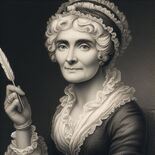 Artist's conception: AI generated Image About the authoress:
Artist's conception: AI generated Image About the authoress:There is no information for Mrs. Isaacs from the usual bibliographic and literary sources. She did not write prefaces for her novels, so the bottom line is, I know nothing about her. A Bibliographical Guide to Anglo-Jewish History suggests that Mrs. Isaacs might be Jewish, but there is nothing in the novel to indicate this; the clergymen, churches, churchyards, and death-bed scenes, are all Christian. She published seven books, including a compilation of short stories and poems which includes a few noble titles in her list of subscribers. Looking over the list of subscribers, I can’t even tie her down to a particular part of England. She had several different publishers, including Minerva Press.
Scholar Veena Kasbekar has this to say about William Lane, the proprietor of the Minerva Press: ‘’Because of the second- or third-rate nature of his publications, Lane’s contribution to women’s literature has not been fairly gauged. Whether or not he exploited them as hack waters, he provided indigent women with a source of income by publishing their works." Previous post: Soaring above mediocrity
Published on January 04, 2024 00:00
December 28, 2023
CMP#166 Sir Edward, the principled hero
 Clutching My Pearls is dedicated to countering post-modern interpretations of Jane Austen with research that examines her novels in their historical and literary context. I also read and review the forgotten novels of the Georgian and Regency era and compare and contrast them with Austen's. Click here for the first post in the series. Click here for my six critical questions for scholars. CMP# 166 Book Review: The Wife and the Lover (1813), (not to mention the idiotic husband)
Clutching My Pearls is dedicated to countering post-modern interpretations of Jane Austen with research that examines her novels in their historical and literary context. I also read and review the forgotten novels of the Georgian and Regency era and compare and contrast them with Austen's. Click here for the first post in the series. Click here for my six critical questions for scholars. CMP# 166 Book Review: The Wife and the Lover (1813), (not to mention the idiotic husband)
 If you really loved me: Image generated by Bing AI The Wife and the Lover is not about a wife who has an affair, as I first surmised. “Lover” in this case refers to a unrequited love, or chivalric love. We first meet the darn-near-perfect hero, Sir Edward Harcourt, talking with his guardian and mentor, Lord Fanshaw. Fanshaw warns Sir Edward, who has recently inherited his baronetcy, to think twice before marrying the beautiful and accomplished Cecilia Fitzallard. Lord Fanshaw does not object to the fact that Cecilia does not come from a distinguished family, or have a large fortune; the problem is that she is rather too full of herself, and apt to take offence where none was intended.
If you really loved me: Image generated by Bing AI The Wife and the Lover is not about a wife who has an affair, as I first surmised. “Lover” in this case refers to a unrequited love, or chivalric love. We first meet the darn-near-perfect hero, Sir Edward Harcourt, talking with his guardian and mentor, Lord Fanshaw. Fanshaw warns Sir Edward, who has recently inherited his baronetcy, to think twice before marrying the beautiful and accomplished Cecilia Fitzallard. Lord Fanshaw does not object to the fact that Cecilia does not come from a distinguished family, or have a large fortune; the problem is that she is rather too full of herself, and apt to take offence where none was intended.Sir Edward, however, is head-over-heels for Cecilia.
Lord Fanshaw’s own wife Horatia accidentally proves that the lord had a point; when Horatia makes some joking remarks about Cecilia, which are carried back to her by a character helpfully named Tabitha Wormwood, Cecilia is incensed. She demands that Sir Edward cut off ties to the Fanshaws immediately and forever.
Our hero can’t do it; he owes the Fanshaws, especially Lord Fanshaw, “both gratitude and esteem." Cecilia, accusing him of not loving her enough, breaks off the engagement. Sir Edward leaves his affairs in the hands of his steward and goes abroad to heal his broken heart.
Cecilia has many other admirers, including a visiting German count who is a renowned soldier back in the German principality of *****. Count Falkenstein had an “unfavorable opinion” of “women in general, nor could he forbear to express his disapprobation of the freedom which the English ladies, both before and after marriage, enjoyed.”
A little foreshadowing here: we are told that the count is honorable, brave, handsome, and noble, but he expects unquestioning obedience from a wife. After he and Cecelia are married, he writes to his relatives back in Germany to assure them that she is not like the other outspoken English ladies: “My lovely bride has a just conception of the gentle duties of her sex, and adores that nice sense of honor which cannot tolerate the levity too prevalent in a country where the fair sex enjoy almost unlimited liberty,”
So, are we setting up for a story where the heroine realizes, too late, that she threw away a wonderful man and rashly married a tyrant? You might think so. You might assume that the narrator is going to take Cecilia’s side in what follows.
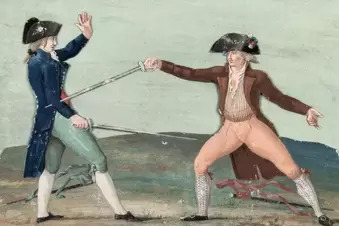 Nice going, Mr. "Death before dishonor" The Honeymoon is Over
Nice going, Mr. "Death before dishonor" The Honeymoon is OverCecilia and the count move back to Germany, the honeymoon is over, and they start quarreling, but the narrator faults Cecilia for not being forbearing enough. The count is in a bad mood already because he’s fallen out of favour with his ruler. As for Cecilia, he thinks she’s flirting too much. During one of their quarrels, he exclaims: “From this moment, Cecilia, you are free… I will deliver you from the presence of a husband you no longer love…. I will seek an honorable death in some foreign land. My fortune is your’s. Farewell, for ever!” Does Cecilia say to herself, "I guess I was emotionally manipulating Sir Edward the same way--now I see how wrong I was"? Nope.
Cecilia begs her husband to forgive her, lest she be a victim of “eternal anguish and remorse.” Falkenstein forgives her while acknowledging “Though at moments, I fear, I am captious and unjust, this heart while it beats will throb with affection for the most lovely and beloved of women. Bear with its infirmities, dearest Cecilia, with that sweetness you have, till of late, so often shown..”
The count, we must understand, is not a manipulative, controlling, Teutonic jackass. No, the count is a a hero of sensibility. His honour means more to him than his life. His “heart pants” to “rush on the face of danger… and reap fresh laurels on the field of renown,” yada yada, and Cecilia, with the approval of the narrator, struggles to appease and obey him.
Before long the count, impelled by an insult to his honor, challenges his political rival to a duel, and loses. Cecilia is a widow in a foreign country before she’s 20 years old, and her sister-in-law, like Fanny Dashwood in Sense and Sensibility, can’t wait to kick her out of the castle, which now belongs to the count’s six-year-old nephew. Cecilia “was not ignorant that the castle and estate, as the count had left no child, would devolve to his eldest nephew; but… Cecilia could not suppose that [her sister-in-law] could forget what was due to the memory of a generous and noble brother.” Hmmm, is Miss Holcroft saying something about the injustice of primogeniture and the inheritance laws of the principality of ****, or is she just setting up a dramatic plot point? I vote the latter.
Now Miss Holcroft turns to the first in a chain of coincidences. Who happens to be in the adjoining room in the inn where Falkenstein fights his fatal duel? Who rushes to console him in his dying moments? Who brings the mournful news to the castle? Yes, it’s Sir Edward.
Of course he wouldn’t be so crass as to attempt to revive his romance when Cecilia has only just been bereaved. And she is so ashamed of having rejected him over a trifling joke made by Lady Fanshaw that she declares: “pride and propriety raise an insurmountable barrier between us, and we must never meet again!”
Never, you got that? Never, because insurmountable reasons.
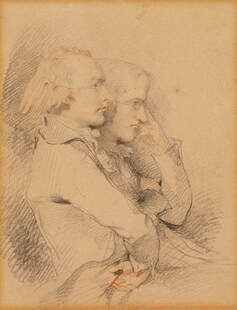 Thomas Holcroft (foreground) and William Godwin. National Portrait Gallery And now for something completely different
Thomas Holcroft (foreground) and William Godwin. National Portrait Gallery And now for something completely differentThe authoress now keeps us all in suspense while inserting an Italian semi-gothic subplot or two, involving more duels, rapacious priests, and convents, in which Sir Edward helps a young Italian nobleman. Up until now, The authoress has mostly used narration with little dialogue to tell her story. In this middle section of the novel, we switch abruptly to long stretches of dialogue between Sir Edward and some European nobleman who sit around talking about various things, including dueling.
It is often said that Jane Austen never wrote a scene involving only men. Miss Holcroft has no such reticence--she doesn’t hesitate to give us page after page of male conversation. I surmise it is because her father was the writer Thomas Holcroft, and she grew up in the middle of a tight-knit coterie of London radicals. William Godwin (Mary Wollstonecraft’s husband), was always dropping by and the men would sort out the problems of the world until the small hours of the morning.
We’ll skim through this lengthy dialogue to get back to the main plot, only pausing to notice another example of a character expressing an opinion about the condition of women: Speaking of the Turks, a baron says: “Oh, do not name a set of barbarians… who are not only slaves and infidels, but who are the tyrants of the fair sex: were I, like them, blessed with four wives, instead of being their jailor I would be their humble suitor, and I should love them all so extravagantly that not one of them should suspect she had a rival in my heart.”
This ties in with my observation that people in Austen's time tended to see the women of England as being fortunate to be English, as compared to women in other countries, particularly in the East and the Far East. So, where were we?
I need to back up a bit and mention that Sir Edward does good deeds wherever he goes in the course of the novel, like rescuing a family from highwaymen. Back at university, he helped out a poor fellow student, Theodore Elton, who got suckered into losing a lot of money at gaming. Theodore goes on to become a clergyman, like his father. Wherever Sir Edward goes or whatever kind office he performs, he carries a torch for Cecilia, or as they said in those days, he wears the willow.
So Cecilia leaves Germany with a modest pension. She bumps into a family who know Sir Edward, who tell her what a great guy he is, except, gosh, he sure seems to be harbouring some secret sorrow, and isn’t it too bad he never married? He'd make such a great husband. Back in England, Cecilia unfortunately bumps into Tabitha Wormwood, who puts the worst possible construction on everything that’s happened and spreads her malice around town. The foppish Lord Isleworth also exults over Cecilia’s downfall, because she had turned down his hand before accepting the hand of the foreigner. Cecilia ferociously defends her late husband and sends Isleworth packing.
Another aside: although novels like this are usually set amongst the nobility, many specimens of the nobility are presented as deficient in humanity and good sense, such as Lord Isleworth: he is “half conscious that... though a Peer of the realm, and though possessed of fine horses, a fashionable equipage, a French cook, a Swiss porter, and an Italian valet, and though pampered with every luxury that wealth could procure, with all his fancied importance, in reality, was an insignificant, not to say a contemptible being.” This is not necessarily a condemnation of the aristocracy in general. In these novels, there are Good Aristocrats, who fulfill their duties, and Bad Aristocrats, who are evil, and Foolish aristocrats, who are weak and selfish and foppish. Isleworth is one of those.
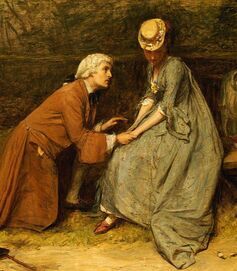 The Proposal, by John Pettie, 1869 (detail) “[A]s the reader will probably have divined”
The Proposal, by John Pettie, 1869 (detail) “[A]s the reader will probably have divined”More amazing coincidences follow: Cecilia falls very ill at an inn and is assisted by a young clergyman and his sister. It's Theodore Elton and his sister! She wants to live out of society, so she finds a quiet home with a clergyman and his wife. Their son, also a clergyman, comes to visit, with a young Italian friend. Yes, it’s the Eltons, as well as the young Italian nobleman who Sir Edward helped out of some scrape or other back in Italy.
Both Theodore and Casimir fall in love with our heroine, so she escapes, seeking deeper solitude in the Scottish highlands. And who should she run into in the middle of nowhere but Tabitha Wormwood? This time, she decides to go to Paris and enter a convent. Surely she won’t run into anybody she knows there. But guess who is renting the adjoining room in the inn on the way to London? Hint: Cecelia overhears him talking about his deathless love for her.
Still deeming herself unworthy, Cecilia continues to Calais, where just about everybody shows up, including the Fanshaws (remember them?) and Theodore Elton. And Sir Edward. He drops to one knee and proposes--"accept the vows of your adoring Edward"--and she finally says 'yes.'
The story is quickly wrapped up after that. Elton and the young Italian count conquer their passion for Cecilia and the author awards them with nice wives; we are assured that Lord Isleworth is miserable in his marriage with Lady Augusta Merton… a peeress in her own right: "his lady, like himself, was proud, haughty, narrow-minded, and destitute of every mental or personal grace: he was miserable at home, and comfortless abroad…” Sir Edward and Cecilia are happy ever after because, as Mr. Knightley put it to Mrs. Weston in Emma, Cecilia understands "the very material matrimonial point of submitting your own will, and doing as you were bid."
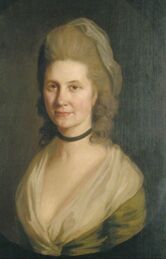 Miss Holcroft by John Opie About the author: soaring above mediocrity
Miss Holcroft by John Opie About the author: soaring above mediocrityThe Critical Review said of The Wife and the Lover: " Generally speaking, our best novelists are females. Miss Holcroft... does not class with the higher order, but certainly soars above mediocrity... The language is chaste, and so is the moral."
It's been a while since we've had a portrait of one of our forgotten authoresses. Sometimes we don't even know their life dates. Fanny Holcroft (1780–1844), like her father Thomas Holcroft (1745-1809), was painted by Amelia Opie's husband, because her father was part of a coterie of radical intellectuals to which the Opies belonged in the heady days of the French Revolution. "Bliss was it in that dawn to be alive, but to be young was very heaven" and Fanny was just old enough to catch the enthusiasm, the ferment of ideas, the hope that a new age was dawning for all mankind. (In comparison, Godwin's daughter Mary Shelley was born in 1797, during the anti-Jacobin backlash, when life for Holcroft and Godwin was much like being a blacklisted Hollywood writer during the Red Scare.)
Thomas Holcroft was a man who put his political principles first, and in consequence, was charged with treason (but the charges were dropped), and he was often on the brink of debtor’s prison. Fanny Holcroft’s confidence in taking her characters to Europe--something Austen would never have attempted--is explained by the fact that her father took the family to Europe for three years, partly because he had become so unpopular in England, and partly to escape his debts.
So why does the daughter of a radical, an associate of William Godwin and Mary Wollstonecraft, write a novel advocating wifely submission? Is she rebelling against dad and reverting to a conservative outlook? As it happens, her father also created a long-suffering forbearing wife in his play The Deserted Daughter (1795), and Godwin's publishing company sold books for young ladies which advocated wifely submission. Was it their sincere belief that wives should submit to their husbands? Or were they all writing to the market? Or was it ironic subversion? I doubt it was the third thing, but possibly the second. Scholar Amy Garnai has examined Fanny Holcroft's plays and concluded that in her plays “as well as in her novels, Fanny never moves beyond conventional themes, behaviors, and tropes.”
If Miss Holcroft didn't believe in the message she was preaching in this novel, she had a very good reason for trimming her beliefs to the prevailing winds of opinion. When Holcroft died in 1809, he left six children under the age of ten. Fanny’s stepmother and her step-siblings were literally facing homelessness and starvation. Their friends wanted to help, but were disastrously poor themselves. So, full respect to Fanny Holcroft; she tried starting a school with her stepmother, she worked as a teacher and a music teacher, and lived out the rest of her life in Miss Bates-like genteel poverty. One of her former pupils called her a "Quixote... in Honor and Truth," that is, someone who was so earnestly virtuous, so sweet and idealistic, that she was a bit eccentric.
Fanny Holcroft died “of mania” in 1844, age 64. Incidentally, chalk The Wife and the Lover up as yet another novel in which a character is dispatched to the West Indies purely to remove him from the sphere of action. Once Lord and Lady Fanshaw serve their purpose in the novel's opening, they hop on a boat. Lord Fanshaw is kept offstage, serving as the governor of one of the West Indies colonies until he is needed for the novel's conclusion. And he is a Good Aristocrat, remember. Miss Holcroft was by no means indifferent to slavery--she wrote the abolitionist poem, The Negro, but she used the West Indies to park the Fanshaws in until she needed them.
The West Indies would have had unhappy personal associations for Fanny Holcroft because her half-brother William committed suicide, aged 16, in a ship that was set to sail for the West Indies. He had bought passage with money stolen from his father, and when Holcroft came looking for him, he shot himself. A grim family tragedy. Later, Holcroft thought that Godwin had based a stern father in his novel Fleetwood on this tragedy, and he broke with Godwin. They were only reconciled on Holcroft's deathbed.
Garnai, Amy. Thomas Holcroft’s Revolutionary Drama: Reception and Afterlives. Rutgers University Press, 2023.
The full and fascinating story of William Godwin and his circle is told in William St. Clair's book The Godwins and the Shelleys: A Biography of a Family. Johns Hopkins University Press, 1991. Previous post: The debate over female education
Published on December 28, 2023 00:00
December 17, 2023
CMP#165 Power Over Themselves
 This blog explores social attitudes in Jane Austen's time, discusses her novels, reviews forgotten 18th century novels, and throws
some occasional shade
at the modern academy. The introductory post is here. My "six simple questions for academics" post is here. CMP#165 Book Review: Power Over Themselves: the Literary Controversy about Female Education in England, 1660-1820, by Veena Kasbekar
This blog explores social attitudes in Jane Austen's time, discusses her novels, reviews forgotten 18th century novels, and throws
some occasional shade
at the modern academy. The introductory post is here. My "six simple questions for academics" post is here. CMP#165 Book Review: Power Over Themselves: the Literary Controversy about Female Education in England, 1660-1820, by Veena Kasbekar
 Ladies examining a globe: Adam Buck (1759-1833) The debate around female education in the Georgian and Regency periods of England was an astonishingly long-lived and vigorous dispute that was taken up in drawing rooms, newspapers, journals, advice books and even novels of the period.
Ladies examining a globe: Adam Buck (1759-1833) The debate around female education in the Georgian and Regency periods of England was an astonishingly long-lived and vigorous dispute that was taken up in drawing rooms, newspapers, journals, advice books and even novels of the period.In Power Over Themselves, Veena Kasbekar outlines the prominent voices and arguments on each side of the female education debate--I say "each side" because the debate is roughly divided into "radicals" like Mary Wollstonecraft and "reactionaries" like Hannah More. While Kasbekar makes it clear which team she's on, she presents the arguments clearly.
When I started reading novels of the long 18th century, I was surprised how often the topic of education came up, and how often the education the heroine or some other character received, or didn't receive, was mentioned by the author either directly or indirectly. For example, in Mansfield Park, Jane Austen stresses that Maria and Julia Bertram received a thorough education in dates and facts, but imbibed no moral principles. In Persuasion, Anne Elliott's knowledge of literature, poetry, and belles lettres is just about the only thing that can console her in her dreary life.
Kasbekar writes that novels "served an implicit educational purpose by demonstrating how the hero's or heroine's education directly influenced her or his reaction to the vicissitudes of life and love." As in novels, so it was in eighteenth-century life: in Power Over Themselves, Veena Kasbekar recounts how the writers, philosophers, and moralists of the past fiercely debated what sort of education women should receive, what sort of knowledge they were equipped to handle, the purpose of that education, and the dangers of too much education.
I am personally interested in the novels but many types of literature are discussed in Power Over Themselves, including the infamous conduct books and sermons for young women, and guides to female education, written for women by women.
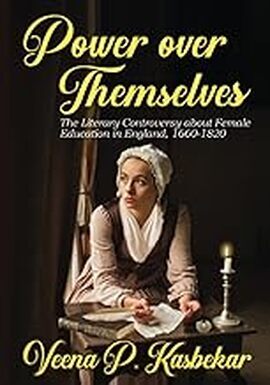 Thanks to Kasbekar's thorough study of the voices of the past, we have an invaluable resource and overview of the debate about female education, from the earliest proponents for education for women, to the reformers of the Victorian age. Most people today have heard of Mary Wollstonecraft, but there is so much more to the story, with names and books and arguments you might not know about. For example, in 1779, a man named William Alexander published A History of Women, from the Earliest Antiquity to the Present Times. Kaskebar explains that ''among other things, he celebrated women's contributions to society and to the progress of civilization itself, especially the invention of spinning and sewing and in the field of medical knowledge.''
Thanks to Kasbekar's thorough study of the voices of the past, we have an invaluable resource and overview of the debate about female education, from the earliest proponents for education for women, to the reformers of the Victorian age. Most people today have heard of Mary Wollstonecraft, but there is so much more to the story, with names and books and arguments you might not know about. For example, in 1779, a man named William Alexander published A History of Women, from the Earliest Antiquity to the Present Times. Kaskebar explains that ''among other things, he celebrated women's contributions to society and to the progress of civilization itself, especially the invention of spinning and sewing and in the field of medical knowledge.'' Kasbekar also takes note, and we should remember, that the debate was mostly confined to the small slice of upper-class and middling gentry. In other words, class as well as gender comes into this. It was more generally agreed that the lower class of women needed an education in some useful trade because they, unlike gentlewomen, needed to work. As well, both sides agreed that a focus on acquiring accomplishments like singing, playing, and drawing, was a frivolous waste of time. ''The radicals were especially scornful of the excesses of the education of the person, which system included a detailed attention to physical appearance, dress, and the accomplishments. By encouraging such an education, argued Wollstonecraft, male writers from Rousseau and Gregory to Edmund Burke... attempted to ensure that women remained artificial, weak creatures, whose sole interest in early life was to secure a husband through the arts of a mistress rather than through reason and virtue.'' Hannah More, the conservative writer, agreed, but for different reasons: ''She objected that girls were educated only for the transient period of youth, for a crowd rather than for living at home, for the world and not for themselves (that is, spiritually), for show and not for use, for time and not for eternity.''
The last section of the book takes us into the Victorian era, when attitudes toward women in the professions, and access to higher education for women, finally began to change, "after two whole centuries of agitation by feminist thinkers."
Power Over Themselves would be a great starting-point for anyone doing research into female education in this period, or the debate around women more generally.
Power Over Themselves, although adapted from a thesis and thoroughly referenced, is refreshingly readable and free from academic jargon or pomposity. If you are undertaking a study of feminism or female education in this era, start with this book!
For some of my past blog posts about female education, start here. Previous post: A biracial hero
Published on December 17, 2023 00:00
December 12, 2023
CMP#164 George Arrandale, the biracial hero
 Clutching My Pearls is dedicated to countering post-modern interpretations of Jane Austen with research that examines her novels in their historical and literary context. I also read and review the forgotten novels of the Georgian and Regency era and compare and contrast them with Austen's. Click here for the first post in the series. Click here for my six critical questions for scholars. CMP#164 Book Review: A Summer at Weymouth (1808)
Clutching My Pearls is dedicated to countering post-modern interpretations of Jane Austen with research that examines her novels in their historical and literary context. I also read and review the forgotten novels of the Georgian and Regency era and compare and contrast them with Austen's. Click here for the first post in the series. Click here for my six critical questions for scholars. CMP#164 Book Review: A Summer at Weymouth (1808)
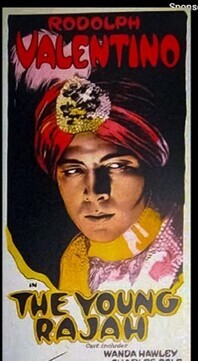 Irresistible to the ladies A Summer at Weymouth is a novel written in imitation of the immensely popular A Winter in London by Thomas Skinner Surr (1806), which I reviewed here. The novel touches on many of the preoccupations of the day, but first we have to talk about the fact that a love-rival for the heroine is biracial and nobody has an issue with this. “[A]lthough his dark complexion discovered him to be on one side the son of an Indian, the regular beauty of his features, the sensible expression of his fine dark eyes, and the symmetry of his graceful form adorned by the most polished manners rendered him the admiration of all who beheld him.” He is “skilled in the Persian, Arabian, and Indostan music, and sung the songs of those languages with great expression.” He also dances divinely. Our main heroine, Stella Fitzalbion, knew him from boyhood and has a crush on him.
Irresistible to the ladies A Summer at Weymouth is a novel written in imitation of the immensely popular A Winter in London by Thomas Skinner Surr (1806), which I reviewed here. The novel touches on many of the preoccupations of the day, but first we have to talk about the fact that a love-rival for the heroine is biracial and nobody has an issue with this. “[A]lthough his dark complexion discovered him to be on one side the son of an Indian, the regular beauty of his features, the sensible expression of his fine dark eyes, and the symmetry of his graceful form adorned by the most polished manners rendered him the admiration of all who beheld him.” He is “skilled in the Persian, Arabian, and Indostan music, and sung the songs of those languages with great expression.” He also dances divinely. Our main heroine, Stella Fitzalbion, knew him from boyhood and has a crush on him.George is the adopted ward of the Earl of Charlewood and was raised along with the Earl’s own children. He returned to India at 18 to fill a "lucrative and honorable post" and acquired a “considerable fortune.” He “knows only that [his parents] died when he was an infant, but has never heard who they were.”
Hmmm… a man of color, of unknown parentage, accepted into society? What is the answer to the mystery which clings about him?
Young George happens to meet Mr. Russell, an older merchant returned from India, who is struck by George’s strong resemblance to the Rajah Abdalla. Mr. Russell goes on to mention that many years ago, a fire broke out at the Rajah’s palace, and the women of the palace, “all ran out terrified, wives and children, among a regiment of European soldiers” who had come to help fight the fire.
Mr. Russell goes on to add that months later, Abdallah mourned “the death of a favourite daughter, [the Princess Roseatenissa] who was to have married his brother’s son; which marriage had been delayed on account of her ill health, occasioned by her extreme terror on the morning of the fire. That young lady was, they said, a perfect beauty, and very accomplished…”
 East India Company factory at Cossimbazar, India, 1795 It's a mystery!
East India Company factory at Cossimbazar, India, 1795 It's a mystery!I’ve become interested in the question of hints and clues in old novels after reading Lady MacLairn, which has some subtle clues about Big Family Secrets. Did other writers deploy their hints as subtly as Jane Austen, who placed a lot of clues in Emma about Frank Churchill’s true love interest? What about the clues in A Summer at Weymouth? Did the readers of Jane Austen’s time say to themselves, “A-ha! I betcha that George Arrandale is the son of Princess Roseatenissa and an English officer. And, they must have been legally married. So, no doubt, the princess converted to Christianity, and she managed to hide her pregnancy thanks to the help of one faithful servant, and then she died. In other words, any objection you could possibly raise against George Arrandale as a prospective husband for an English girl, has been answered."
Well, if that’s what they guessed, they were right. Another hint comes when George Arrandale tells Stella's uncle and guardian, Admiral Fitzalbion, that the Earl (his own guardian) had forbidden him to court Stella. He can court any other English girl, that is, but not Stella.
Once Mr. Russell and the Earl of Charlewood receive word that Rajah Abdallah has died, the Earl of Charlewood is free to reveal the Big Secret: George is really the son of Colonel Henry Fitzalbion, “to whom [the princess] was married, for whom she became a Christian, and with whom, had heaven spared her, she would have come to England.” The Earl kept George's parentage a secret to protect George (now Henry Fitzalbion) from the curse of his grandfather “the Rajah… being a faithful and strict believer in Mahomet."
Biracial--but half-English, and of royal blood on his mother’s side, George/Henry inherits his late father's baronetcy and is recognized as the nephew and “undoubted heir” of his uncle Admiral Fitzalbion. He is the older half-brother of the heroine Stella, so we had a little incest frisson there. He marries Lady Charlotte Charlewood. The tenants rejoice. Formula for a "season" novel
As I mentioned, A Summer at Weymouth was written to cash in on the popularity of A Winter in London. Young has used Thomas Skinner Surr’s formula for a “season” novel, meaning that we have:discussions of current events and social issues of the day that are unrelated to the plot. In Weymouth, this is usually Stella and her war-hero uncle. They talk about female modesty in dress, libel laws, and the importance of the British Navy. They both give spirited speeches against the practise of impressment.lengthy descriptions of the dresses worn by the female characters and the decorations for parties and balls. One can imagine females of the middling and lower ranks soaking up these details with avidity.characters who are thinly disguised satirical portraits of real members of the aristocracy. I suspect that Sir Pic-nic Haut-ton is based on some real person, but I don’t know who. There is also a Duchess of B_____. As well, "types" are satirized, such as the lounging dandy, the over-rouged old lady, the scantily-clad young miss. While harsh in its lampooning of excesses of the titled class, the "season" novels are patriotic and even slavish in their praise of the Royal family. Nor do all aristocrats come in for a pasting. Stella and her friends and relatives are decent, benevolent members of the nobility who are good stewards of their lands and kind to their tenants. As for the other characters, the names give it all away: Sir Pic-nic Haut-ton, the Duchess of Zephyrly, Lady Frivola, the Marquis of Rosebower, the Countess of Everbloom, Paradel Gossamer, Lord Splendormore, and Captain Hoaxer. Yes, it's a large cast of characters; this is just a partial list. There's the loyal servant Triton Oakheart, dishonest landlords Mr. and Mrs. Grubb, a chorus line of loyal tenants, and even more titled lords and ladies.
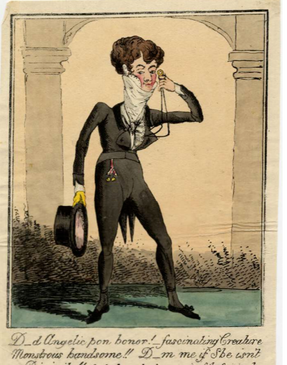 Drawling, lounging dandies. George Cruikshank, 1817, British Museum More spoilers
Drawling, lounging dandies. George Cruikshank, 1817, British Museum More spoilersStella Fitzalbion, our main heroine, meets with no tribulations or dangers. She is rich, noble, beautiful, and accomplished. In the course of the three volumes, she attends a masquerade ball without being abducted, she enjoys London society and the company of her friends, and the worse thing that happens to her is an alarm when her childhood friend Edward Elmsberry fights a duel and nearly dies, an event which precipitates his confession of his love for her and her decision to accept him as her husband.
Any singular and romantic incidents happen to the other secondary characters. Dermot O'Roon is afraid to tell his father he's married to a poor curate's daughter back on the family estates in Ireland. Anne Stuart must survive being orphaned, preyed upon by the licentious General Lawless, cheated of all her belongings and her money, and owning only the mourning clothes on her back, sitting bereft on the shoreline at Southampton, before she fortunately bumps into her long-lost uncle Mr. Russell.
The authoress ruthlessly kills off superfluous characters, especially women, to create the requisite number of heiresses looking for husbands, confirmed old bachelors in search of somebody to leave their money to, and orphans in need of rich uncles. Yes, it is odd how confidently some people assert that “women couldn’t inherit” in Jane Austen’s day, when most of the females in this book control their own fortunes, and the heroine is a countess in her own right, because her late mother was "the Earl of Grassmere's only child," thus her mother was also countess in her own right. Plus we have two ambitious social climbers with enormous fortunes. This is not to say that independent heiresses were thick on the ground in Austen's time, but the fact that they exist in the pages of a novel set in high life means they weren't entirely unknown in real life.
In short, A Summer at Weymouth is a voyeuristic fantasy that both lampoons and revels in the excesses of the titled classes. Exposition and Austen's technique
We learn Stella’s backstory in the first few pages through some trite dialogue, the kind where characters tell each other things they already know very well: “The untimely deaths of your dear parents, in your early infancy, left you to my guardianship, and never had an uncle a more dutiful niece…” “Cruel war!” [responds Stella] it deprived me of a father before I saw the light! It deprived me of a mother soon after my birth, because the fatal stroke that slew her Henry gave a mortal wound to her poor heart!”
Compare this to how Austen fills us in on the story while at the same time leaving the characters to reveal their personalities. Here is one speech from Mr. Weston, speaking affectionately of his son and insultingly of his wealthy sister-in-law: "'She is an odd woman!—But I never allow myself to speak ill of her, on Frank’s account; for I do believe her to be very fond of him. I used to think she was not capable of being fond of any body, except herself: but she has always been kind to him (in her way—allowing for little whims and caprices, and expecting every thing to be as she likes). And it is no small credit, in my opinion, to him, that he should excite such an affection; for, though I would not say it to any body else, she has no more heart than a stone to people in general; and the devil of a temper.'” About the authoress:
Mary Julia Young was a hard-working author who wrote in several genres. Her busy publishing career extended from approximately 1790 (or earlier) to 1810. Scholar Nicola Lloyd says “dates of Mary Julia Young's birth and death are not known and very little information about her family and upbringing remains.” Young, like so many impoverished authors before her, applied to the Royal Literary Fund (RLF). In her 1808 application, Young mentions that she is the sole remaining member of “two large families” having "survived six brothers and sisters and twenty five cousins." She does not mention a husband. The Fund directors relieved her distress with a donation of fifteen pounds.
Lloyd’s examination of Young’s novels reveals that she had an “acute awareness of literary fashion.” Stella delights her uncle Admiral Fitzalbion with a rendition of ""Peaceful slumb'ring on the ocean" from Stephen Storace's opera The Pirates. Young wrote two “season” novels: this one, and A Summer at Brighton, but kept her name off the title page, perhaps because she knew that these novels, "while remaining pro-morals and anti-fashionable society, were often considered salacious and immoral.” When the rage for “season” novels died down and the next big thing was “conservative [i.e. religious] domestic fiction,” Young switched genres and wrote a novel which “contrast[ed] the idleness and libertinism of the gentry with the industriousness and benevolence of the merchant classes.”
An earlier novel, The East Indian, is not about a person of color. The main character is a blue-eyed daughter of an Indian "Nabob," or wealthy English merchant. The East Indian is a gothic novel with a Scooby-doo plotline, again showing how adept Young was at adapting her style to the tropes and plot points of multiple genres. Incidentally, the incest tease was often used in Gothic novels and in some sentimental novels as well. According to British women poets of the Romantic era : an anthology, The East Indian includes "a Jewish moneylender with a heart of gold," which would be another striking example of Miss Young's progressive attitudes at a time when Jews were either execrated or the butt of bigoted humor.
Mary Julia Young also wrote poetry and plays. Perhaps at the behest of her publisher, she frequently described herself as a relative of the poet Edward Young (1683-1765), author of the poem "Night Thoughts," a poem much better-known back then than today. Perhaps "Night Thoughts," a meditation on grief, was eclipsed by Tennyson's 'In Memoriam." At any rate, I'm sure Miss Young would have been even more specific about her connection to the poet if he'd been her grandfather or great-uncle, but she can only describe herself as a relation. Edward Young appears to have been the only surviving son of his father, the Rev. Edward Young (1641-1705) Edward Young the poet had only one son, Frederick Young (1732-1781), who appears to have died without issue, so any connection to the poet is a collateral one going further back in the family tree. She says that Edward Young the poet stood as godfather to her own brother Edward, but what little information we have did not help me find a record for a "Mary Julia Young," probably born between 1750 and 1765.
Young is listed in Dale Spender's influential anthology, Mothers of the novel: 100 good women writers before Jane Austen, but Spender's bestowal of "good" on each of her 100 women writers appears to arise more out of feminist solidarity than critical examination. The Orlando database of Women Writers says of Young: "Though capable of intelligent and interesting work, she was obviously turning out pot-boilers late in her career."
We can say, however, that Young was a professional working woman, a true pioneer for a woman of her time and social class, and in George Annandale, she created a sympathetic biracial character who was not killed off or otherwise marginalized in her story. Lloyd, Nicola. "Mary Julia Young: (PDF) A Biographical and Bibliographical Study." Romantic Textualities. 18 (2008)
Feldman, Paula R. "Mary Julia Young." British women poets of the Romantic era: an anthology. Baltimore, Md.: Johns Hopkins University Press, 1997, pp. 844-845
Spender, Dale. Mothers of the novel: 100 good women writers before Jane Austen. London/NY:Pandora, 1986
Previous post: The trials of Albinia
Published on December 12, 2023 00:00
December 4, 2023
CMP#163 Albinia, the long-suffering heroine
 Clutching My Pearls is dedicated to countering post-modern interpretations of Jane Austen with research that examines her novels in their historical and literary context. I also read and review the forgotten novels of the Georgian and Regency era and compare and contrast them with Austen's. Click here for the first post in the series. Click here for my six critical questions for scholars. CMP#163 Grim reality: The Splendour of Adversity (1814) by Mrs. Bayfield
Clutching My Pearls is dedicated to countering post-modern interpretations of Jane Austen with research that examines her novels in their historical and literary context. I also read and review the forgotten novels of the Georgian and Regency era and compare and contrast them with Austen's. Click here for the first post in the series. Click here for my six critical questions for scholars. CMP#163 Grim reality: The Splendour of Adversity (1814) by Mrs. Bayfield
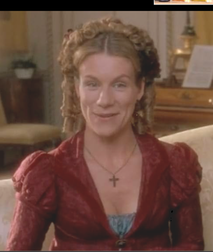 Blessed with resources within herself: Mrs. Elton in Emma (Juliet Stevenson) “'More domestic scenes? More village anecdotes? More fireside conversations?'” To these questions we will answer in the affirmative…."
Blessed with resources within herself: Mrs. Elton in Emma (Juliet Stevenson) “'More domestic scenes? More village anecdotes? More fireside conversations?'” To these questions we will answer in the affirmative…."This is how Mrs. E.G. Bayfield opens her novel The Splendour of Adversity, a domestic novel and it’s why I picked it to read. I wanted to see another example of a domestic novel, set in a country village, like Jane Austen's Emma. Austen's novel is famous, this one, published two years earlier, is forgotten, but they both represent a conscious move away from melodramatic "sentimental" novels with their abductions, forged wills, and mislaid foundlings, in favour of situations that were, as Austen would say, “probable” and close to real life.
Splendour opens with a chat around a whist-table in a quiet village, as some local widows and spinsters talk over the late rector of their village and the arrival of the new one. His name is not "Knightly," as one lady had announced, but Knightwell. And it turns out that Jane Colyer, a quiet spinster who has been living in Hazlebury for a few years, already knows him.
We then flash back to the reason why Knightwell and Jane were unable to marry. Rev. Knightwell was on the point of proposing, but his brother died and he had to take care of his widow and four children, so he couldn't afford to begin a family of his own. Now that he's moved to Hazlebury, Mr. Knightwell and Miss Colyer reunite as friends “and thus did the estimable pair emulate and encourage one another in the exercise of superior virtue.” She helps educate the children, especially the oldest girl, Albinia. Their mother the widow is “destitute of any internal resources," unlike Mrs. Elton in Emma, who is blessed with them. The Widow Knightwell wants to enjoy the social life at some seaside resort instead of living quietly at the rectory. If I tell you she rouges her cheeks (!) then I've told you everything you need to know about the artful hussy...
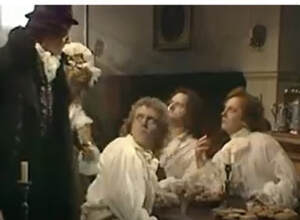 Romantic poets in Blackadder; "Be quiet, sir. Can't you see we're dying?"
This vale of tears
Romantic poets in Blackadder; "Be quiet, sir. Can't you see we're dying?"
This vale of tears
As the title hints, this book is about handling adversity with Christian fortitude--adversity which tests, refines, and prepares the soul to be worthy for Heaven. There is so much adversity that I began to wonder: “so how realistic is this, exactly?” But after all, don’t we have selfish mothers who neglect their children, and don’t we have neighbours embroiled in horrible feuds in modern life? So the situations are not that improbable, I suppose.
You are also reminded of the difference between a realistic novel with realistic characters and a sentimental novel with sentimental characters, when Lionel Saverland, the son of the previous rector, comes rushing into the rectory garden like a dime-store Shelley and starts emoting all over the shrubbery. “'Yes! Here it is—Oh! Sacred shade, witness, witness my emotions at this moment! How have I longed, how have I sighed for such an opportunity as this! Yet now that it is arrived I cannot enjoy it as I would—Oh! Bitter--bitter retrospective memory!' And with an air of wild suffering” he rushes away, to bump into Albinia, who is instantly smitten.
Lionel loathes his current clerical posting in the city of **** and he yearns for a living in the country: He resents having sophisticated city congregations nitpick at his sermons and in particular, he is repulsed by the “wretched habitations of squalid famine.” He’d much rather encounter a starving peasant in a rural setting: “To approach the death-bed of the honest and virtuous cottager, who inhabits a tenement on the wild mountain’s brow, to speak words of comfort, hope, and peace, to the departing soul of him who has warded off poverty by labour, and who has been trying to do his duty in his contracted sphere—this would be happiness—it would be pleasure of the purest kind! But to enter the noisome chamber of disease, brought on by sloth and intemperance, to hear the dreadful imprecation, to see the blood-shot glaring eye!”
Miss Colyer warns him: “Oh! Lionel Saverland, if you do not repress this discontented, this fastidious spirit of yours, it will be a barrier to your happiness.”
A few years go by, and Lionel's dream comes true. He marries Albinia and off they go to their country parish. What could go wrong?
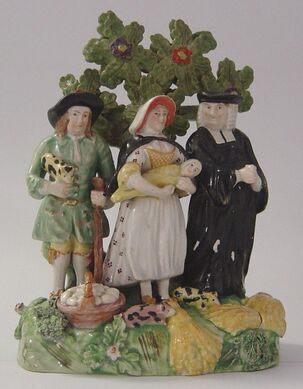 The Tithe Pig-- set this on the mantelpiece when the vicar comes for tea
Unpleasant characters
The Tithe Pig-- set this on the mantelpiece when the vicar comes for tea
Unpleasant characters
Meanwhile, Albinia's younger sister Rose is lucky enough to snag an Irish peer as her husband. But the authoress does not throw a veil of sentimental romance over the marriage. Lord and Lady Brereton are described in the typical way that nobility are described in these books—they are selfish and live for pleasure. It never occurs to Rose to help out her poorer relations.
The authoress also throws in a bigamist fortune-hunter, an Amazon, and a maidservant who has married her master (but she is no Pamela, see more below).
The main antagonist doesn’t show up until volume three. He is a wealthy farmer who enlists all the other ratepayers in his parish to refuse to pay tithes to Lionel Saverland, our sensitive vicar. This is the first novel I’ve come across in which the payment of tithes features in the plot. Austen lampooned the issue in her Plans for a novel in which the heroine’s clergyman father “expires in a fine burst of Literary Enthusiasm, intermingled with Invectives against holders of Tithes.”
Here, the narrator's sympathies are for the minister in this Hardy-esque battle of wills, despite his self-indulgent emotionalism, but this was not always the case. Clergyman were often lampooned as fat, lazy, gout-ridden port guzzlers at this time. "Take the pig, but take the child," says the hard-pressed farmer's wife in the poem "The Tithe Pig," here depicted in Staffordshire pottery. Our authoress is not concerned with critiquing British institutions like the Anglican church. Like Austen, she examines character, and if people behave well or badly in the station of life in which they are placed.
It is sad to see Lionel's dreams of being a wonder-working minister in a village end with the humiliation of preaching to empty pews. Yes, Lionel Saverland is a Sensitive Plant, but he is an object lesson for the reader. Despite his weaknesses, Albinia loves and supports him with unswerving devotion, as a wife should.
We've seen Rev. Knightwell give up his own happiness to support his ungrateful brother’s widow, and seen Rev. Saverland sinking into debt while his parishioners abandon him to go listen to some itinerant Methodist, but the greatest adversity of all in this novel is caused by… (da dunh dunnnh!) ....DEW!
 Killer dew!
Beware the dew! Spoilers
Killer dew!
Beware the dew! Spoilers
Rev. Knightwell is carried off before his time by a “cold, which originated from being out too late in the autumnal dew,” which “settled on [his] lungs."
The youngest Knightwell nephew, also named Ambrose, is an invalid for life because he is left on the sea-shore by his neglectful mother: “to amuse himself by picking up shells on the shore, till his clothes were moistened by the evening dew, or wetted with the salt spray of the sea.”
And finally, Lionel Saverland, driven to frenzy by the cruelty of Farmer Mallow, rushes out into the pouring rain (okay, that’s even worse than dew) and broods in the darkness down by the river. He is further injured when he stops Farmer Mallow’s runaway carriage-horse, risking his own life to save that of his bitterest enemy, but surely it was the damp that caused his demise shortly after.
Albinia and Lionel’s story ends tragically, and in fact this novel does not end with a wedding, but with reflections on the need for fortitude and self-control and not expecting too much out of life. Once widowed, Albinia turns down an offer of marriage and instead, starts a school to support herself and her two children. So if you think marriage-plot novels are unrealistic, you can try the dismal, dew-filled doings of The Splendour of Adversity. "The rules of composition"
I was disappointed in this story because the authoress started off with three or four families in a country village, but didn't stay with them. We meet a few village characters, such as Mrs. Follett, a widow who is described thusly: “her foibles were common ones, the extremes of neatness and cleanliness, and a little eagerness for the chit-chat of the village, which is almost universal in minds which are destitute of resources, and where occupation is merely corporeal.” But after introducing us to Mrs. Follett, Mrs. Staple, and Mr. Nutcombe all gathered around the whist table, the action moves away from Hazlebury. I was particularly interested in "Miss Donaldson." She is the first portrait of a neurodivergent person that I’ve encountered in this old literature. She knows how long the previous rector served the village: “Fourteen years, two months, and three days!” She sets everyone straight as to dates, places, and times. She is "unmoved" when a man’s coat catches fire. But she plays no part in the story.
Austen is much more skilled at giving her minor characters, however eccentric, something to do in her plots. As well, she pays attention to the unities of the plot when it comes to introducing and dismissing characters. She makes reference to this near the end of Northanger Abbey when the narrator tells us about Eleanor's marriage to a nobleman who was not mentioned earlier in the story: "aware that the rules of composition forbid the introduction of a character not connected with my fable—that this was the very gentleman whose negligent servant left behind him that collection of washing-bills." In Emma, we don't meet Miss Bates and Jane Fairfax until volume two, but they are discussed in volume one. We hear about Mr. Elliot and we see him in Lyme at the end of volume one of Persuasion before he is re-introduced to us in volume two. Well yes, the poultry thieves in Emma were introduced at the last minute...
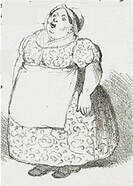 Fat, vulgar, relatives
Fat, vulgar, relativesOne gathers that no heroine, however saintly, should have to put up with fat relatives. The marriage proposal Albinia turns down comes from her uneducated but well-meaning cousin Frederick, who is a rustic country squire. His mother is a former-cook-maid who married her master, and she is ridiculed for her weight: “her large and unwieldy person, and fat capacious sides, exceeded all that Albinia could have imagined of vulgarity, even of a cook-maid transplanted to the parlour, yet she tried to dissemble her disgust, and, with good humoured sweetness, followed her into the house.” The mother pressures Albinia to marry her son, and she would often "plead his cause... sometimes pinning Albinia completely in her place by spreading her great bulk before her, as she sat in the window….” until the “good lady waddled off…”
 About the author:
About the author:
Mrs. E.G. Bayfield is thought to be the author of The Splendour of Adversity. If another of her title-pages is to be believed, she is also the author of The Woman of Color (1808), a novel which has received much critical attention recently as the main character is a Jamaican heiress who experiences racism during her visit to England. The Splendour of Adversity does not deal with slavery or empire. It has references to the Peninsular War and its heroines are "patriotic." It has one passing mention of the "East India charter." The Rev. Knightwell's brother goes to the West Indies but as a soldier. He does not get rich; he dies of yellow fever.
The Splendour of Adversity received two short but favourable reviews: “This novel is a very respectable attempt to call novel readers back to a love of truth and nature.” The Monthly Review notice was written by Laetitia Matilda Barbauld, a prominent bluestocking writer, who opined: “Though the title of this book may be deemed affected, the tale will be found simple, and rather pleasing, some of the characters are drawn with skill and discrimination; and the tendency of the whole is favourable to virtue.”
Previous post: Maria, the saucy heroine
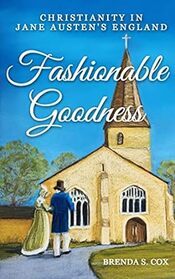 For more about Laetitia Matilda Barbauld and her book reviews, see Waters, Mary A. "‘'Slovenly Monthly Catalogues': The Monthly Review and Barbauld's Periodical Literary Criticism". Nineteenth Century Prose, vol. 31, no. 1, 2004, p. 53.
For more about Laetitia Matilda Barbauld and her book reviews, see Waters, Mary A. "‘'Slovenly Monthly Catalogues': The Monthly Review and Barbauld's Periodical Literary Criticism". Nineteenth Century Prose, vol. 31, no. 1, 2004, p. 53.For more about the unreliability of author attribution, see Garside, P. D. ‘Mrs Ross and Elizabeth B. Lester: New Attributions’, Cardiff Corvey: Reading the Romantic Text 2 (June 1998). Mrs. Bayfield's "'chaste pen'... got associated with a chain of potboilers."
For more about tithes, the difference between a rector, a vicar, and a curate, and all things related to the church and religion in Jane Austen's England, I recommend Fashionable Goodness by Brenda S. Cox.
Clerical incomes, city ministers versus country ministers, the role of a clergyman in a country village and absentee clergymen are all discussed in Mansfield Park, especially in the conversations between Mary Crawford and Edmund Bertram.
Published on December 04, 2023 00:00
November 27, 2023
CMP#162 Maria, the saucy heroine
 Clutching My Pearls is about Jane Austen. I also read and review the forgotten novels of the Georgian and Regency era and compare and contrast them with Austen's. Click here for the first post in the series. Click here for my six critical questions for scholars. CMP#162 A review of The Portrait, by Miss Elliott (1783): 18th century girlpower!
Clutching My Pearls is about Jane Austen. I also read and review the forgotten novels of the Georgian and Regency era and compare and contrast them with Austen's. Click here for the first post in the series. Click here for my six critical questions for scholars. CMP#162 A review of The Portrait, by Miss Elliott (1783): 18th century girlpower!
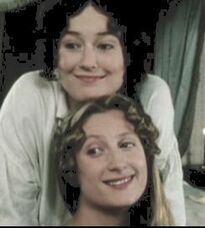 Saucy and sweet In an earlier post I suggested that Pride and Prejudice is so magical because Austen had the good sense to demote Jane Bennet from main heroine status and promote the saucy sidekick to main heroine. In novels of this era, the formula called for the sweet and virtuous heroine to have a saucy friend and confidante, who is allowed to say irreverent or catty things that the heroine cannot.
Saucy and sweet In an earlier post I suggested that Pride and Prejudice is so magical because Austen had the good sense to demote Jane Bennet from main heroine status and promote the saucy sidekick to main heroine. In novels of this era, the formula called for the sweet and virtuous heroine to have a saucy friend and confidante, who is allowed to say irreverent or catty things that the heroine cannot.Elizabeth Bennet made an unusual main heroine because she was so outspoken and “arch,” as Austen calls her, while demure Jane would never say or even think a critical word against anybody.
I have found another example of this sweet-girl/saucy-sidekick switcheroo, in the sprightly two-volume novel The Portrait (1783) by a “Miss Elliott.”
Maria Bellmont is the sauciest of the saucy. Naturally I assumed she was a saucy sidekick because The Portrait opens with a letter from her sister Charlotte, writing to their friend Harriot Marchmont. I thought Charlotte would be the main heroine, but Charlotte gets married in the first volume, and the lively Maria takes center stage for the rest of the novel.
Not only that, but the deus ex machina in the novel is another "girl power" female, Lady Mortimer, who comes up with a ploy to help Maria win the man she loves.
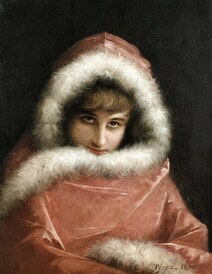 The Eyes Have It. Alonso Perez A cloaked beauty 1890 The hero, William Bellmont, has little more to do in the story but fall in love with Maria, and rant and rave when his grandfather forbids the match. Maria and William are first cousins, so they have the same paternal grandfather, which feels even weirder than Edmund Bertram and Fanny Price in Mansfield Park. But that’s not why grandfather forbade the match—he wanted William to marry a rich heiress. William declines to give his hand where he could not give his heart, and grandfather scoffs: “Why the fellow talks like a girl… what the devil has your heart and all that kind of nonsense to do with it? You have been reading romances I fancy, by way of completing your education: Prythee let’s hear no more of these sentimental rhapsodies.”
The Eyes Have It. Alonso Perez A cloaked beauty 1890 The hero, William Bellmont, has little more to do in the story but fall in love with Maria, and rant and rave when his grandfather forbids the match. Maria and William are first cousins, so they have the same paternal grandfather, which feels even weirder than Edmund Bertram and Fanny Price in Mansfield Park. But that’s not why grandfather forbade the match—he wanted William to marry a rich heiress. William declines to give his hand where he could not give his heart, and grandfather scoffs: “Why the fellow talks like a girl… what the devil has your heart and all that kind of nonsense to do with it? You have been reading romances I fancy, by way of completing your education: Prythee let’s hear no more of these sentimental rhapsodies.”But I'd better back up to the beginning. The story moves as swiftly as a Russian troika over the frozen steppes, which is where we are told Charlotte and Maria are headed because their father has been appointed to a government post in Russia. Charlotte is unhappy but, heroine-like, accepts her father's decree, even though it breaks her heart to leave behind her friend Harriot’s brother Harry. Maria says of Charlotte: “she can look forward to the dear delights of the Russian Court with all the nonchalance of a philosopher; while I die with impatience to be covered with fur from head to foot; to be whisked over the snow in my elegant carriage, attended by half a hundred freezing beaux, whose only chance of being thawed is by the fire of my bright eyes.”
 Grandpa threatens to disinherit his heir. Maria goes on to boast that she gets the local young swains to declare that they don’t care about hunting, really, in their eagerness to ingratiate themselves with her. She also makes fun of another suitor, and I think we can read between the lines here: “When it first popped its little head out of the carriage, I took it for a Miss in full regimentals, which is now quite the ton, you know;--and but that it had no petticoats, I should have continued in the same error to the last moment of its visit; in the course of which it talked so prettily, lisped so softly every word it uttered, and spoke with such terror of our neighbouring fox-hunters, and other beings of that robust nature, that I was fifty times on the point of offering my smelling-bottle.” (Sidebar: isn't it funny to think that, if we believe the old novels, refined females routinely carried smelling salts with them, in case they or any other females fainted, which suggests fainting was a common response to stress.)
Grandpa threatens to disinherit his heir. Maria goes on to boast that she gets the local young swains to declare that they don’t care about hunting, really, in their eagerness to ingratiate themselves with her. She also makes fun of another suitor, and I think we can read between the lines here: “When it first popped its little head out of the carriage, I took it for a Miss in full regimentals, which is now quite the ton, you know;--and but that it had no petticoats, I should have continued in the same error to the last moment of its visit; in the course of which it talked so prettily, lisped so softly every word it uttered, and spoke with such terror of our neighbouring fox-hunters, and other beings of that robust nature, that I was fifty times on the point of offering my smelling-bottle.” (Sidebar: isn't it funny to think that, if we believe the old novels, refined females routinely carried smelling salts with them, in case they or any other females fainted, which suggests fainting was a common response to stress.) The sisters' letters to their friend Harriot also set out the backstory of the Bellmonts: Charlotte and Maria’s father is the younger son of a nobleman who threw him off when he married for love. After having two daughters and one son, the mother died, which is very often the case in these novels. Dad hopes to regain some of his lost social standing with the prestigious post in Russia. But when he goes to London to make his final arrangements, he catches a cold and then dies, which means the trip to Russia is off. The girls mourn him, but his death removes the impediment to Charlotte's marriage to Harry. Their brother, Captain Charles Bellmont, is on hand to condole the sisters for the loss of their father and later, to celebrate the wedding.
Maria's plan to slay hearts by the dozens is interrupted when she meets and falls in love with her cousin William, and he with her. But grandfather, who has refused to have anything to do with this branch of the family, forbids the match, as I mentioned.
 Young English Augustinian nun, Paris Spoilers--Lovers separated
Young English Augustinian nun, Paris Spoilers--Lovers separated Maria squares up to reality and resolves she will not do as her own parents did—she will not marry without Lord Bellmont’s consent, or put William in the position of losing his future title and fortune. William swears he won’t give her up, so Maria decides to go into hiding until he calms down and accepts the inevitable. “I am to continue a while to play the part of a heroine.” The characters, particularly Maria, pertly speak of themselves as people in a novel, with remarks like: “and thus ends volume the first of he adventures of William Belmont, Esq. and the fair Maria. Should a second be published, I will send it you.”
When William is distraught over Maria’s disappearance, brother Charles writes: “We durst not leave him to govern himself, so brought him here with us; he raves and storms like any hero, but we shall make shift to manage him, I hope, till we resign that important charge to you; and that I trust, nay am certain, will be soon.”
William would rave and storm even more if he knew that when Maria was travelling by herself to get away from him, her carriage was waylaid by Lord Bellmont’s servants, who take her to a convent in France on his orders. Maria decides to cooperate and go along for the ride rather than bring on a confrontation between William and his grandfather. The plot twist is dramatic, even Gothic, but there is nothing Gothic about Maria’s descriptions of her abduction or the nuns at the convent. “I will only say, it requires more beauty than comes to the share of every female, to look even tolerable in the dress these good souls wear.”
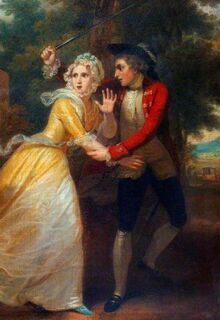 The heiress elopes Other British young ladies are also in the convent. Maria befriends Miss Mortimer and her mother, Lady Mortimer. Lady Mortimer knows the Bellmonts and their unhappy backstory. She decides to help Maria convince Lord Bellmont to change his mind about forbidding the match.
The heiress elopes Other British young ladies are also in the convent. Maria befriends Miss Mortimer and her mother, Lady Mortimer. Lady Mortimer knows the Bellmonts and their unhappy backstory. She decides to help Maria convince Lord Bellmont to change his mind about forbidding the match.Meanwhile, brother Charles has been luckier in love. He has married an heiress, and it just happens to be the same heiress that Lord Bellmont wanted his grandson William to marry, so one part of grandpa's plan is thwarted. The new sister-in-law, Anne Bellmont, being of age and an heiress, chose Charles for her husband and eloped with him to Gretna Green, another exxample of female empowerment in the novel. Neither Anne or her sister-in-law Maria believe in affecting false modesty about their charms or their influence on their menfolk.
Maria returns with the Mortimers to England, still not allowing William to know where she is, and she takes an assumed name, Miss Neville. Lady Mortimer invites Lord Bellmont, who lives nearby, to pay her a visit. Maria arranges to be playing the harpsichord and singing when he enters the parlour: “the important moment at length arrived, down I sat, and choosing a song so soft, so plaintive, that it would have melted the heart of a savage, I began…”
A few more performances, and some of her witty repartee, and Lord Bellmont is so enchanted that he invites the Mortimers and their lovely little friend Miss Neville back to his estate. Lady Mortimer encourages him in thinking of Miss Neville as a future granddaughter-in-law. Lord Bellmont only resists on the grounds that he knows his grandson is in love with someone else, but agrees to invite William to come and meet Miss Neville anyway, in the hopes that he'll forget the other chit he's in love with.
 Epistolary heroines Maria loses her composure
Epistolary heroines Maria loses her composureThe trickery is revealed when, touring Lord Bellmont’s estate, Maria enters the picture gallery and sees her late father’s portrait hanging there. (Hence the title of the novel.) Fortunately for the plot, Grandpa Bellmont never took down the portrait of his disinherited son. Maria cries, "my father, my revered, my beloved father," and faints dead away.
William confesses that the lovely Miss Neville is really the girl he loves, and Lady Mortimer pleads: “Let me, my Lord, implore you to pity those poor children, forget what is past, and let me have the consolation to see that the innocent stratagem I have contrived, has produced the happy effects I so ardently wished.”
Lord Bellmont agrees, as Maria is a “treasure.”
The lovebirds can plan their future and the sundered family is reunited.
Later, Maria saucily recounts a conversation with William: “By Heaven,” [William exclaims, as he embraces her] “I believe Nature never formed your equal.”
“No, certainly,” said I, disengaging myself. “I hope this is not the first time you have been convinced of this incontestable fact. Why, even Lord Bellmont is of that opinion, who has not known my wonderful perfections half so long.”
Happy endings all around, and as I say, when we review the personalities and actions in this novel, it’s all very female-driven. The female characters even give Harry a hard time for getting Charlotte pregnant: “Ah! My poor Charlotte!—what a pretty hand she has made of herself! Dear creature, how I long to see her in her present graceful state!— I could find in my heart, tell her, to give [Harry] Marchmont a lecture for serving her such a wicked trick…”
The Portrait is a nice little Georgian amuse-bouche. There is a passing reference to losing the American colonies, and one mention of Eastern wealth, but the only slaves are the captives of Maria's charms. About the author:
Miss Elliot’s identity has not been established. An early reviewer (The European Magazine and London Review) said: “Miss Elliott… is a young Lady in genteel life and sister to the ingenious Mrs. Hall [another novelist]… [she] possesses an uncommon felicity in discriminating characters… The character of Maria, in The Portrait, does Miss Elliot great credit.” Miss Elliott also wrote The Relapse (1780) and The Masqued Weddings (1781). Mrs. Hall’s novel, The Modern Wife (1769) is available on Internet archive. None of Miss Elliott's novels have forewords, which is sometimes a place to pick up some glimmer of information about the author.
Now a last detail for the knowledgeable Emma fan: The Relapse begins with the same breezy style in Letter I from Miss Hastings to Mrs. Sidley: 'I long exceedingly to see you, my dear cousin, and no less do I long to see your caro sposo.'" Maria writes that she played the song "Amanda" to charm Lord Bellmont. Not the 1986 Boston power ballad surely. She may be referring to a poem by James Thomson but I have not found a musical version of it.
And thou, Amanda, come, pride of my song
Form'd by the Graces, Loveliness itself !
Come with those downcast eyes, sedate and sweet
Those looks demure, that deeply pierce the soul,
Where with the light of thoughtful reason mix ..
Or perhaps she is referring to "Amanda's Fair," possibly by the British composer Thomas Arne, who gave us "Rule Britannia." This shseet music is courtesy of the Sibley Music Library, Eastman School of Music at the University of Rochester. The lyrics fit the message that Maria is trying to convey to Lord Bellmont:
Amanda's fair by all confessed
Her skin soft snowy white
As down that clothes the soft turtle[dove]'s breast
Her eyes like diamonds bright
Yet further still the nymph excels
In each celestial grace
That midst the heart's soft labryinth dwells
Or in the soul takes place.
 Previous post: Book review: The Interest
Previous post: Book review: The Interest
Published on November 27, 2023 00:00
November 16, 2023
CMP#161 Abolitionists versus "The Interest"
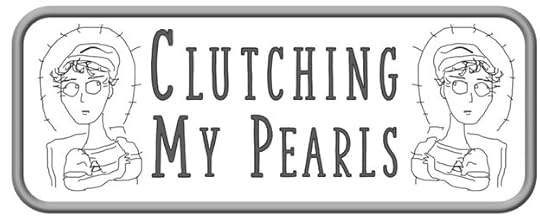 This blog explores social attitudes in Jane Austen's time, discusses her novels, reviews forgotten 18th century novels, and throws
some occasional shade
at the modern academy. The introductory post is here. My "six simple questions for academics" post is here. CMP#161 Review: The Interest: A Comprehensive History of the Abolition Debate by Michael Taylor
This blog explores social attitudes in Jane Austen's time, discusses her novels, reviews forgotten 18th century novels, and throws
some occasional shade
at the modern academy. The introductory post is here. My "six simple questions for academics" post is here. CMP#161 Review: The Interest: A Comprehensive History of the Abolition Debate by Michael Taylor
 If you're looking for a comprehensive history of the campaign to abolish the slave trade and slave ownership in Britain's Empire, this book would be a good choice. An astounding amount of research has gone into it and Michael Taylor is a good writer with an eye for the apt quote. He explains the arguments--personal, pragmatic, economic, religious, and political--raised by the influential power brokers who opposed the abolition campaign. Taylor also gives us frequent and vociferous condemnations of slavery. I presume this is not because he feels we, his readers, must be convinced that slavery is bad, but rather to forestall anyone who thinks that if he explains the plantation-owners' point of view, he is somehow defending them. It is jarring to see, for example, cartoons from the time which poke fun at the abolitionists.
If you're looking for a comprehensive history of the campaign to abolish the slave trade and slave ownership in Britain's Empire, this book would be a good choice. An astounding amount of research has gone into it and Michael Taylor is a good writer with an eye for the apt quote. He explains the arguments--personal, pragmatic, economic, religious, and political--raised by the influential power brokers who opposed the abolition campaign. Taylor also gives us frequent and vociferous condemnations of slavery. I presume this is not because he feels we, his readers, must be convinced that slavery is bad, but rather to forestall anyone who thinks that if he explains the plantation-owners' point of view, he is somehow defending them. It is jarring to see, for example, cartoons from the time which poke fun at the abolitionists.We also have graphic detail of the misery of life on a sugar plantation, where the planters protested that (a) life in the West Indies was delightful, better than living in Africa, and (b) enslaved Africans were naturally so indolent and the work so hot and miserable that there was no alternative but to use the lash. Taylor shows how the economic booms and busts of the early 19th century affected the progress of the campaign to free the slaves, and of course it mattered who was in power in Parliament as well. Few abolitionists thought that immediate and total emancipation was likely, but some readers might be surprised to learn that few of them thought it was feasible, either, or thought that Blacks could or should become the social equals of their former captors. Rest assured that if anyone on the abolition side has feet of clay, Taylor points it out. It was interesting to learn that the sainted William Wilberforce did not approve of women getting involved in anti-slavery campaigns, as it was unfeminine of them to push themselves into public affairs. Taylor also names and shames the politicians who had opposed abolition but then flipped and called it a great moral achievement once it was accomplished.
I appreciated all the detail and nuance that Taylor brings to this history. However, as others have mentioned, it's a lot to read and I skimmed the latter part of the book because I was more interested in what was going on during Jane Austen's time, or during the period when her brother Henry was chosen as a delegate to an abolition convention. In addition to learning about all the principal players in the debate, we have lots of detail about the ground-level campaign, what journalists and cartoonists had to say, as well as the testimony of that handful of emancipated Blacks who were able to tell their own story. I also checked out some of Taylor's primary sources. This book is a rich resource for finding the key documents, publications, and even novels of the period.
Slavery came to an end in the United States after a terrible war, costly both in human and material life. In the British empire, owners of enslaved persons were compensated for giving them up, but the enslaved persons, in either case, received no compensation. Slavery is still not eradicated from the globe. In this 1826 cartoon by Robert Cruishank, "John Bull taking a clear view of the Negro Slavery Question!!" Abolitionists looking at the West Indies from a distance are shown as agitating about the dire conditions of enslaved people when, golly gee, it's actually a paradise over there in the sugar plantations with enslaved folks dancing happily.
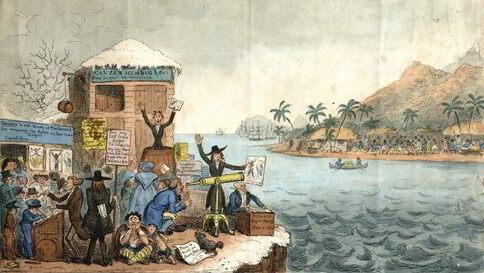 The Interest is adapted from Taylor's PhD thesis. The argument of his thesis, insofar as there is one, is that Britain does not deserve to congratulate itself for having abolished slavery and
fighting the slave trade on the high seas;
that rather, we all should learn more about the role slavery paid in Empire, we should knock anyone (like the Duke of Wellington) who opposed the abolitionists off their pedestals, and we should criticize the abolitionists for not doing or thinking what we surely would have done and thought if we'd been in their shoes. We should name the recipients of the compensation monies and also publicize the names of their descendants. There ought also to be frank dialogue about reparations.
The Interest is adapted from Taylor's PhD thesis. The argument of his thesis, insofar as there is one, is that Britain does not deserve to congratulate itself for having abolished slavery and
fighting the slave trade on the high seas;
that rather, we all should learn more about the role slavery paid in Empire, we should knock anyone (like the Duke of Wellington) who opposed the abolitionists off their pedestals, and we should criticize the abolitionists for not doing or thinking what we surely would have done and thought if we'd been in their shoes. We should name the recipients of the compensation monies and also publicize the names of their descendants. There ought also to be frank dialogue about reparations.So far as I can observe, Taylor's point of view is well on the ascendant. For more on what women did to fight slavery, "Women Writers and Abolition," by Deirdre Coleman, in Volume 5 of The History of British Women's Writing 1750-1830, edited by Jacqueline M. Labbe, lists and quotes the female writers, chiefly poets, who used their talents in the abolition campaign. Many women novelists included the abolition debate in their novels, such as Eleanor Sleath in her book The Bristol Heiress. You can find more examples here. The campaign to boycott sugar was called the Anti-Saccharite campaign. I reference it in my novel, A Contrary Wind. One of my characters, the widow of a Bristol ship-builder, refuses to serve sugar at her tea table. Click here for more about my books. Previous post: Book Review: Lady Maclairn
Published on November 16, 2023 00:00
November 9, 2023
CMP#160 Lady Maclairn: proto-detective novel?
 This blog explores social attitudes in Jane Austen's time, discusses her novels, reviews forgotten 18th century novels, and throws
some occasional shade
at the modern academy. The introductory post is here. My "six simple questions for academics" post is here. CMP#160 Lady Maclairn, the victim of villany (1806) by Rachel Hunter
This blog explores social attitudes in Jane Austen's time, discusses her novels, reviews forgotten 18th century novels, and throws
some occasional shade
at the modern academy. The introductory post is here. My "six simple questions for academics" post is here. CMP#160 Lady Maclairn, the victim of villany (1806) by Rachel Hunter
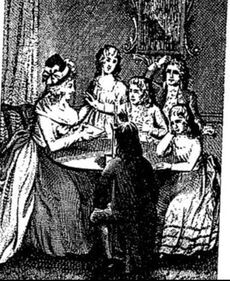 Austen scholars know that Jane Austen was familiar with the 1806 novel Lady Maclairn, the victim of villany (It’s spelled ‘villany’ on the title-page), because her niece Anna recalled how she and her aunt had a good laugh over its emotional excesses. There also exists a short satirical note that Austen wrote to Anna about it.
Austen scholars know that Jane Austen was familiar with the 1806 novel Lady Maclairn, the victim of villany (It’s spelled ‘villany’ on the title-page), because her niece Anna recalled how she and her aunt had a good laugh over its emotional excesses. There also exists a short satirical note that Austen wrote to Anna about it.I wonder if Austen managed to plow through all four volumes and 700 pages. I confess to skimming and skipping the last half, when the author was gearing up to introduce a whole new raft of characters and more subplots and backstories. Austen scholar Deirdre LeFaye counted ‘a total of nearly twenty flashbacks in all,’ and I don’t know if that includes the long narrative summary which commences the novel. However, even though I didn’t manage to read Lady Maclairn cover to cover, this forgotten novel deserves another look for a number of reasons: the attitude displayed in the book toward the slave trade, the Big Family Secret storyline, the naturalistic portrayal of insanity, and the harsh portrait of a clergyman.
It appears that Lady Maclairn did not receive a review when first published. So here goes:
Mrs. Dawson, a wealthy widow, never forgave her son-in-law for taking her daughter away to Jamaica, where she died far from home after giving birth to little Rachel Cowley, our heroine. Mrs. Dawson’s will leaves her fortune to Rachel, but Rachel will only inherit if the father returns her to England to be raised by Mrs. Dawson's respectable friends, the Hardcastles. It is just as well for Rachel, because she is growing spoiled in Jamaica where she can lord it over the enslaved people. Her character improves in England where she grows up with gentle little Lucy Hardcastle and her older brother Horace. Rachel looks up to him and she grows into ‘’the habit of yielding up her will to Horace.’’
‘’The tribute of Horace’s admiration was directed to the cultivating the taste and forming the judgment of'' our heroine....’’
 Fanny and Edmund More backstory
Fanny and Edmund More backstoryMansfield Park aficionados will see the similarity in the description of how Edmund shapes Fanny's mind. Rachel, however, is not a penniless dependent, but an heiress. When she and Horace become childhood sweethearts, dad Hardcastle is worried that he’ll be accused of snaffling the heiress’s fortune for his own family, so he sends Horace away to boarding school in the hopes that their early preference for each other will be forgotten. He takes this seriously. Very seriously.
‘’I would rather see your brother dead, then the husband of this young creature!’’ [he exclaims to Lucy] ‘’or rather, let me implore death for my relief, before I see him pointed at as the base, the interested purloiner of this girl’s affections!’’ He then ‘’wept audibly.’’ You’d have quite the drinking game on your hands if you took a swig every time a character in this book cries. Or dies, for that matter, because we’ve already lost Rachel’s mom, her grandmother, Mrs. Hardcastle and a few other people. And the body count will keep rising, and we’re still in the backstory.
Meanwhile, back in Jamaica, dad consoles himself for his loneliness by taking an enslaved girl as his concubine. ‘’But in this deviation from his hitherto regular and moral conduct, Mr. Cowley forgot not decorum; his favourite resided with privacy at the more remote plantation,’’ where she bears him two sons, who Rachel only learns about when dad dies and her two half-brothers are mentioned in the will. I was intrigued by the existence of these characters but unfortunately, although they are mentioned a few more times (they are brought to England and sent to school), we never meet them and they play no part in the plot.
Dad’s will is a shocker to everyone. It appoints his new lawyer, Mr. Flamall, as guardian to Rachel and pretty much pledges her in marriage to Mr. Flamall’s nephew Philip Flint. Rachel suspects the will is forged, and she resolves to contest it (a lengthy process) and of course, refuses to marry Mr. Flint. She does agree to be packed off to Scotland, to the ancestral home of the Flints, with the confidence of an heiress that nobody dare do anything to her. Our hero Horace is ordered to accompany his ailing friend, Lord Dying-from-Consumption, to sunnier climes in Europe, and Mr. Hardcastle forbids the young sweethearts to correspond with each other. Because she’s a double heiress, Rachel doesn't hide her love like Fanny Price: ’’We wish not to conceal an affection on which our happiness depends. Horace knows that I love him, and I know he loves me and… we shall live for each other.’’ Rachel pledges to wait until she attains her majority at age 25 (according to the terms of the will).
 Mr. Snughead
Mr. SnugheadThen the author introduces a host of new characters and their backstories, with marriages and deaths in bewildering succession. Suffice it to say that Rachel is going to live with Lady Maclairn, who is Mr. Flamall’s younger sister. Lady Maclairn’s first husband Mr. Flint has died and she is now remarried to Lord Maclairn. We also meet the first husband's spinster sister, Lucretia Flint, who is miserable and spiteful, a poor relative named Mary, young and beautiful, and there are more estranged relatives living nearby.
And all that’s just setting the stage for the real commencement of the novel, the epistolary part where Rachel Cowley writes to her friend Lucy Hardcastle. We never see one of Lucy’s answers because it is not necessary for plot purposes. Rachel does all the explaining about the dysfunctional family she’s now living with.
Our confident young heiress is openly scathing and rude to the local clergyman, whom she ridicules in her letters to Lucy. ''In what language shall I convey to your imagination the honours of his head, his tight, perfumed, well-powdered curls’’ and his painfully ''tight lacing’’ by which he reins in his growing corpulence. Rachel takes pleasure in disagreeing with Mr. Snughead, and he ’observed…. That for so very young a lady, I had a very decided spirit.’’
You thought Austen was harsh in her portrait of Mr. Collins? Maybe being a bit risky? Rachel compares Mr. Snughead to a ‘’reptile’’ and a ‘’spider’’: ‘’I cannot crush [people she despises] as many do a poor harmless spider; but I would probe them to the quick, without flinching. Some vices I can pity, but a spirit of defamation is my abhorrence; and an unworthy minister of a religion to which I am attached, as my supreme good, is my antipathy.’’ You see how the author distinguishes between the individual, and the Anglican faith, in her condemnation.
Back to some other characters: Lady Maclairn is the mother of Philip Flint by her first husband, and the mother of Malcolm by Lord Maclairn. Neither of these men turn into candidates for Rachel’s affection. Her preference for Horace is never brought into question. Malcolm is engaged to marry a local buxom farmer’s daughter, and Lucretia Flint is miserable and spiteful about that, too. There are more characters and more subplots, including, I believe, an elopement by a girl named Lydia. If I go back and read that section, I will update.
After Miss Flint administers a beating to poor Mary, Rachel steps in and sends the girl to live happily with Lucy. What a heroine can do when she has money!
Rachel is intrigued and perplexed by Lady Maclairn. The lady of the house is intelligent and gentle, a faded beauty, devoted to her ailing husband, but why does she meekly put up with the treatment Lucretia Flint hands out to her, and to everyone in the household? Why is she so reserved and hard to get to know?
The author drops some clues about Lady Maclairn and her relationship with Miss Flint, but I missed them as I skimmed along. Yes, there is a Big Family Skeleton in the closet, which explains why Miss Flint is so miserable and bossy and yet so seemingly haunted with remorse (she weeps a lot), and why Lady Maclairn is such a doormat in her own home (she weeps a lot).
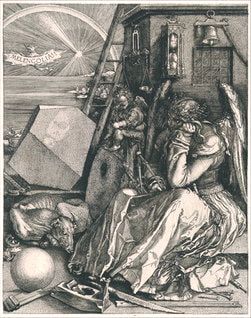 Durer, Melancholia Industrious villain, insanity, and spoilers
Durer, Melancholia Industrious villain, insanity, and spoilers Another interesting feature of this novel is that Lord Maclairn has mental health problems, but he does not rave and wander about like Ophelia in Hamlet. The description of his struggles sounds authentic compared to how fits of madness are described in novels of this ilk. Our heroine grows fond of Lord Maclairn, despite his wandering wits, because when he is feeling well, they can discuss literature and other topics together.
Although Mr. Flamall, the lawyer who forged Rachel’s father’s will, is offstage for almost all of the novel, he shows up in the various family backstories which Rachel uncovers, laboriously transcribes and sends to Lucy. Flamall has been a busy conniving villain. It was he who got rid of his sister Harriet's true love and forced her into both of her marriages to much older men. It was his plan to marry his ‘’nephew’’ (yes, hint, that’s nephew in scare quotes) to Rachel. But his plan is thwarted when Horace, taking a stroll on a Portuguese hillside, happens to come across an Englishwoman in distress with a sprained ankle. He assists and learns that she is the wife of one Philip Flint of Jamaica. Philip is not available to marry Rachel but he (understandably) kept his marriage a secret from ''Uncle'' Flamall.
Okay, okay, I’ll spill the beans although we don’t get to it until the fourth volume, after a long and hard slog through some other subplots and backstories involving many more characters. Lady Maclairn has a guilty secret because she was married already when she was forced into marriage with the elderly Mr. Flint. But the big secret is that Mr. Flamall and the respectable but bitter-hearted Miss Flint had an illegitimate child! She forced Lady Maclairn to pretend the baby was her posthumous child by her first husband. The ladies are trapped in a sort of mutual blackmail situation.
Philip was raised by Lady Maclairn, so he turned into a fairly decent human being. Want proof? Well, among his virtues, he is a humane slave owner. So there you go. A garrulous family servant mentions that Philip inherits ‘’a fine plantation, and I know not how many poor negroes. A good deed for them, poor souls! for Mr. Philip is a tender-hearted man.” And: “Cowley’s slaves are yet cherished as men, though unfortunate men! But I hate the subject.”
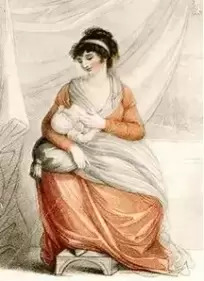 Morally ambiguous at best
Morally ambiguous at bestWhat I see in the passages mentioning Jamaica is not an outright anti-slavery editorial—you can find much more explicit and stronger condemnations in other novels. What I see is a sort of resigned acceptance of slavery as a fact of life, and a distinction made between a benevolent master and a bad master. Others may differ. Although we modern readers would find nothing to excuse in someone who enslaves people for profit, we find many examples of authors speaking complacently of kind and benevolent masters. Such is the case in this novel. As well, I couldn't find any reflection on the fact that much of the heroine's fortune derives from the toil of enslaved people. (For more on how slavery and empire was depicted in these old novels, click on the category ''East and West Indies and Slavery'' above right).
Conclusion--proto-detective novel?
So here we have a novel that Austen and her niece laughed at for its excessive lachrymosity, but which contains some notable features. To investigate whether this is really an early version of a detective novel, I'd have to re-read it again and more attentively to find the clues that point to the Big Family Secret. One that sailed right by me at the time was when the younger brother Malcolm mentions that his mother Lady Maclairn ‘’suckled me herself; her health had not admitted of this duty when Philip was born.'' At other times, Miss Flint says something and Lady Maclairn turns pale and rushes from the room.
I don’t say that Lady Maclairn, victim of villany, was Austen’s inspiration for aspects of Emma—that is unknown and unknowable, but Lady Maclairn deserves a footnote in the history of the novel.
 About the author
About the author Very little is known about Rachel Hunter (1754-1813). The Orlando database of women writer's suggests that she may have come from the merchant class and married a merchant. She had a good education. She was also known as Mrs. Hunter of Norwich. Although Lady Maclairn received no review, another one of her productions, The Unexpected Legacy, received this comment: ''it includes several intermediate narratives, which are each distinct and separate stories: a mode of conducting a novel which divides and subdivides the interest and the attention of the reader; insomuch that we warn him not to be surprised if, after having read the ‘Unexpected Legacy,’ he should scarcely recollect at the conclusion either the nature of the bequest or the merits of the donor.'' Lady Maclairn likewise has no shortage of distinct and separate stories.
I haven't mentioned that Mr. Flamall commits suicide, Lucretia Flint dies of remorse and an infected knee injury, Rachel and Horace marry happily, and Lucy and Mary (the forlorn relative) also find husbands. Lady Maclairn is available online at Project Gutenberg, thanks to the efforts of their wonderful volunteers.
Previous post: Two dutiful heroines Reveries Under the Sign of Austen (blog) has more thoughts about Lady Maclairn. Professor David H. Bell writes about Emma as a detective novel here. Edgar Allan Poe is generally credited with writing the first detective or mystery story in 1841, but I'm going to keep my eyes open going forward looking for books with embedded clues. As opposed to books where the characters pull their hair and gnash their teeth and exclaim that they have a deep dark secret, that is.
Published on November 09, 2023 00:00



